TEAM



Licensed by Dubai Development Authority THE BUSINESS OF CONSTRUCTION August 2023 MEConstructionNews.com 207
Getting Serious About Sustainability NET ZERO ISSUE
KEO ’S SUSTAINABILITY
DISCUSS SUSTAINABILITY STRATEGIES AND WHAT GOVERNMENTS CAN PUT IN PLACE TO USHER IN A NET ZERO FUTURE


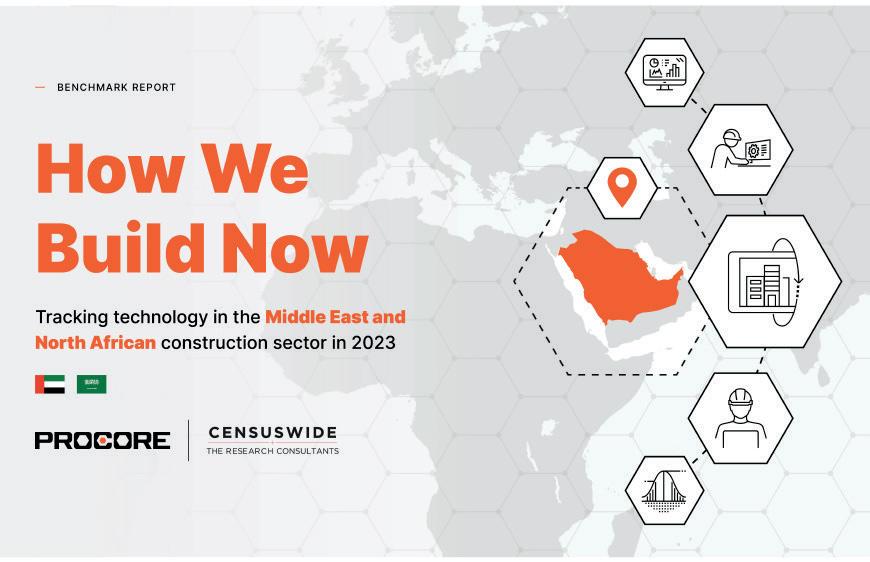
JLL’s
32 Comment
Jason Saundalkar
KEO’s
Jason Saundalkar speaks to AESG’s CTO Adam Muggleton about his new book and the importance of highlighting inspirational figures in the engineering space


A clear strategy highlighting the advantages of owning and operating low-carbon buildings can drive positive changes aligned with national Net Zero targets write Atkins’ Mayuko Totsuka and Dr. Mohsenah Al Yami

36 Comment
Embracing technology and innovative solutions can enable the real estate sector to tackle the challenges of ESG management writes Yousuf Fakhruddin , CEO of Fakhruddin Properties

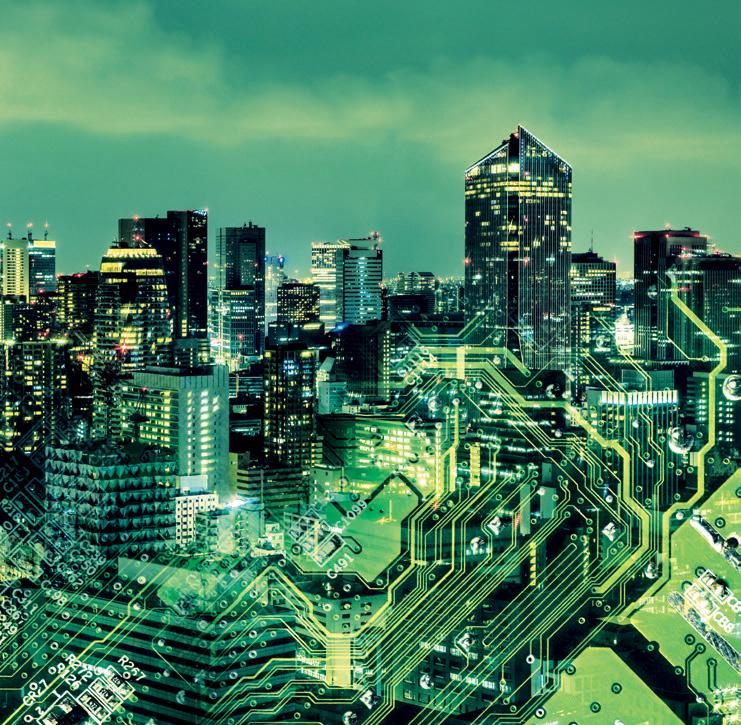
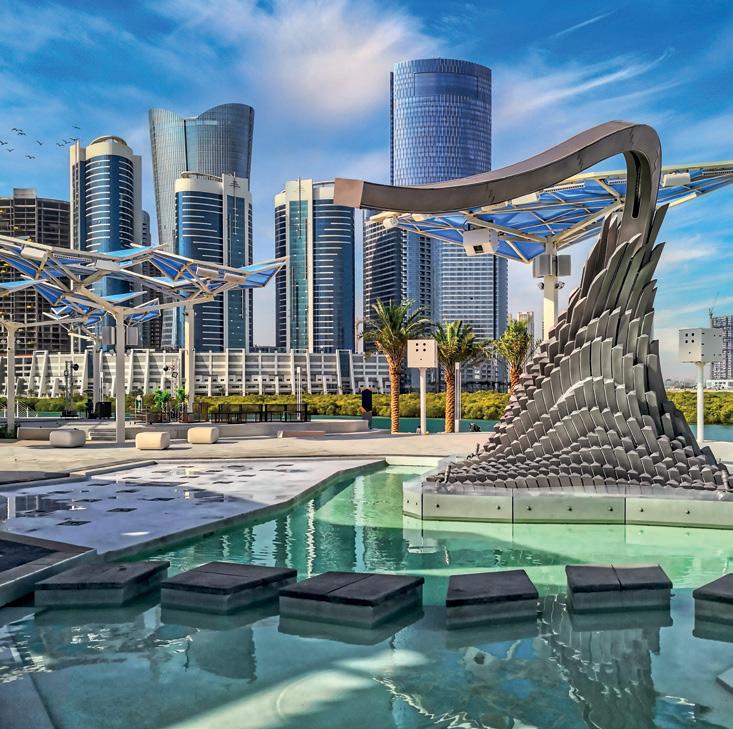
40 Final Update
Red Sea Global has announced the opening of its first mangrove nursery
1 MEConstructionNews.com | August 2023 CONTENTS August 2023
08 14 18 26 32 36 08 The
significant
in
project has been achieved as per BESIX and Hitachi Zosen
12 The Big Picture
wrap-up of the biggest international construction news stories for the month 14 Market Report
ANALYSIS FEATURES INSIGHT
Briefing A
milestone
the Dubai Wasteto-Energy
Inova
A
and
in Q2,
In
Faraz Ahmed shares insights on the supply and performance of Dubai
Abu Dhabi’s residential, office and hospitality spaces
2023 18
Profile Getting Serious about Sustainability
In
speaks to
sustainability team about achieving Net Zero in the built environment 26
Profile Showcasing Excellence
Chasing Net Zero
world. In Africa, work is underway on the staggering US $6.4bn Grand Ethiopian Dam (GERD), which when complete will be able to produce 15,700GWH of electricity per year, whilst bringing other benefits to the surrounding region, including irrigation of agricultural lands.
Welcome to the midsummer edition of Big Project ME (BPME), dear readers. This issue, as you may have gathered, is focused on the crucial topic of achieving Net Zero in the built environment.
In putting the issue together, I was able to speak to a diverse group of people and, on a positive note, it was great to hear broad consensus on what needs to be done to decarbonise, and achieve Net Zero. I do hope you find the insights shared useful and inspirational.
Achieving Net Zero has many different facets, including: reducing energy usage and transitioning to clean energy sources, making better use of resources, eliminating solid waste, and conserving water. That last element will come into sharp focus as BPME hosts the inaugural edition of its Future of Water Summit on the 6th of September in Dubai.
Incredible things are happening in the water space in the region. Already the undisputed king of megaprojects, the MEA region is currently home to some of the most awe-inspiring water projects in the
In the UAE and Saudi Arabia, as well, some of the world’s largest desalination facilities are being developed, in a bid to ensure water security in both countries. At the same time, considerable efforts are underway to make these facilities more sustainable, and reduce their impact on the environment, and decouple them from fossil fuel energy sources.

Later in the month, on the 26th of September, Big Project ME will also be hosting the 2023 edition of its hugely successful Digital Construction Summit. The summit will bring together individuals from a number of globally renowned companies to highlight a variety of techniques/workflows and cutting-edge technology that have the potential to transform the design, delivery and operation of structures and infrastructure. The common thread tying both exciting events together is making the built environment more sustainable and efficient, and I for one can’t wait to hear the discussions on the day. See you then!
Jason Saundalkar HEAD OF CONTENT
jason.s@cpitrademedia.com MEConstructionNews me-construction-news

2 August 2023 | MEConstructionNews.com WELCOME Introduction
Valuable. Easy. Impactful.
Our
The value of ACI membership has never been greater. Our top three benefits are worth thousands of dollars.
• FREE access to all ACI University webinars and on-demand courses.
• Unlimited access to ACI practices (including all ACI guides and reports).
• Connect with over 30,000 global concrete industry professionals.
ACI membership is your most valuable resource in the concrete industry. Join the premier world community dedicated to the best use of concrete.
“ACI is the premier organization for the concrete industry. Becoming an active member will enhance anyone’s professional career.”
ACI Membership means high value.
ACI members know it.
—John F.
Join now at concrete.org
.
Group MANAGING DIRECTOR Raz Islam raz.islam@cpitrademedia.com
MANAGING PARTNER Vijaya Cherian vijaya.cherian@cpitrademedia.com

DIRECTOR OF FINANCE & BUSINESS OPERATIONS Shiyas Kareem shiyas.kareem@cpitrademedia.com


PUBLISHING DIRECTOR Andy Pitois andy.pitois@cpitrademedia.com
Editorial HEAD OF CONTENT Jason Saundalkar jason.s@cpitrademedia.com
+971 4 375 5475
Advertising
SALES EXECUTIVE Madeleine Martin madeleine.martin@cpitrademedia.com
+971 4 375 5714
Design
ART DIRECTOR Simon Cobon simon.cobon@cpitrademedia.com
DESIGNER Percival Manalaysay percival.manalaysay@cpitrademedia.com
Photography
PHOTOGRAPHER Maksym Poriechkin maksym.poriechkin@cpitrademedia.com
Marketing & Events
EVENTS EXECUTIVE Minara Salakhi minara.s@cpitrademedia.com
+971 4 433 2856
SOCIAL MEDIA EXECUTIVE Dara Rashwan dara.rashwan@cpitrademedia.com
Circulation & Production
DATA & PRODUCTION MANAGER Phinson Mathew George phinson.george@cpitrademedia.com +971 4 375 5476
Web Development
WEB DEVELOPER Abdul Baeis abdul.baeis@cpitrademedia.com
WEB DEVELOPER Umair Khan umair.khan@cpitrademedia.com
FOUNDER Dominic De Sousa (1959-2015)
ON THE COVER Big Project ME discusses decarbonisation and achieving Net Zero with KEO’s Sustainability team Licensed by Dubai Development Authority THE BUSINESS OF CONSTRUCTION August 2023 MEConstructionNews.com 207 KEO’S SUSTAINABILITY TEAM DISCUSS SUSTAINABILITY STRATEGIES AND WHAT GOVERNMENTS CAN PUT IN PLACE TO USHER IN A NET ZERO FUTURE Getting Serious About Sustainability NET ZERO ISSUE 4 August 2023 | MEConstructionNews.com MEConstructionNews.com @meconstructionn MEConstructionNews me-construction-news The publisher of this magazine has made every effort to ensure the content is accurate on the date of publication. The opinions and views expressed in the articles do not necessarily reflect the publisher and editor. The published material, adverts, editorials and all other content are published in good faith. No part of this publication or any part of the contents thereof may be reproduced, stored or transmitted in any form without the permission of the publisher in writing. Publication licensed by Dubai Development Authority to CPI Trade Publishing FZ LLC. Printed by Al Salam Printing Press LLC. CPI Trade Media. PO Box 13700, Dubai, UAE. +971 4 375 5470 cpitrademedia.com © Copyright 2023. All rights reserved.
Managing complex construction projects has never been easier
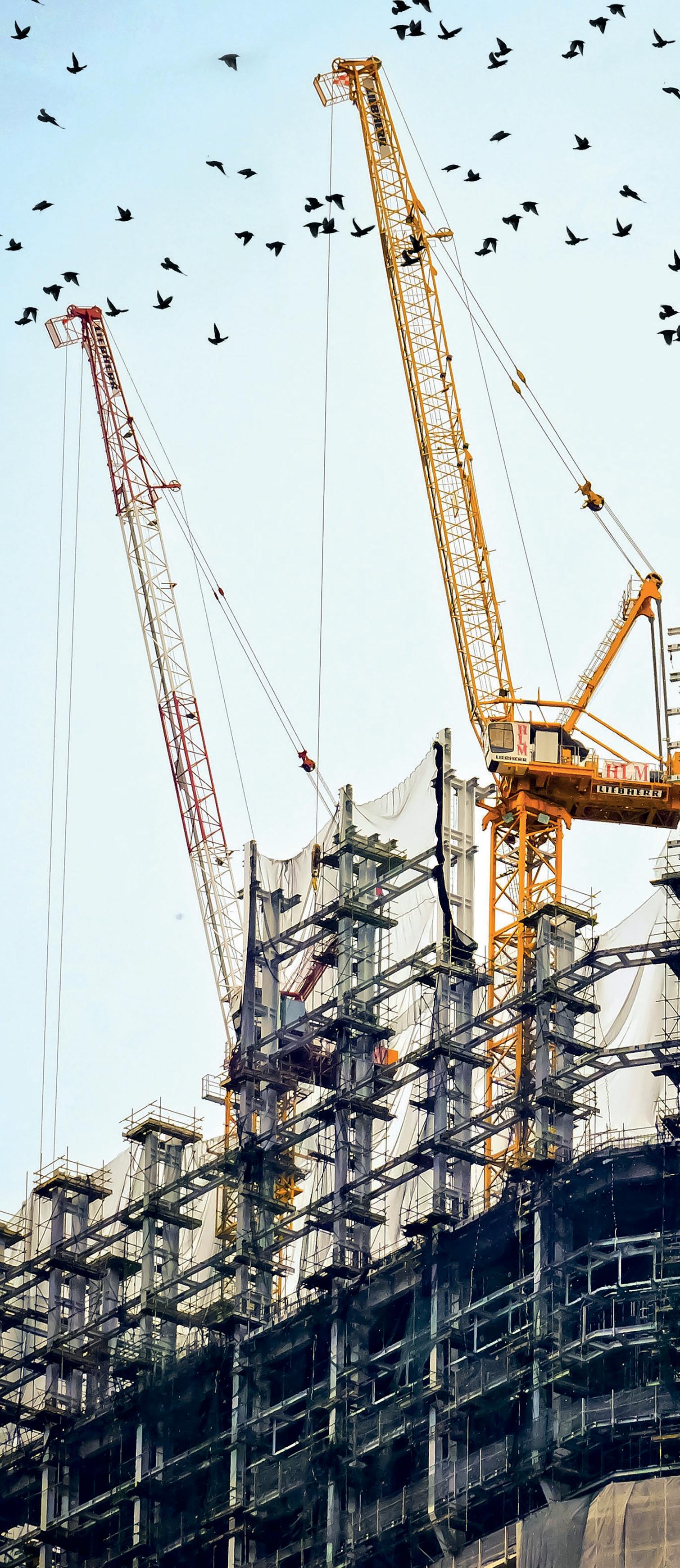
BIM Management
Project Collaboration
Contract Management
Asset Management
Field Management
PROPERTY
Bloom Arjaan by Rotana will be a ‘second home’


FEATURES
CONSTRUCTION
RTA to invest in truck rest stops and lay-bys in Dubai
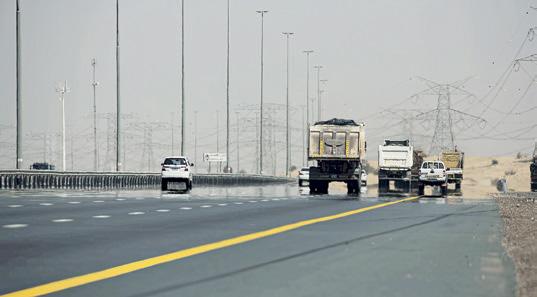
EXPERTS: Middle East markets offer strong cost-to-build value

CONSTRUCTION
Remarkable surge in Abu Dhabi real estate sector as FDI quadruples
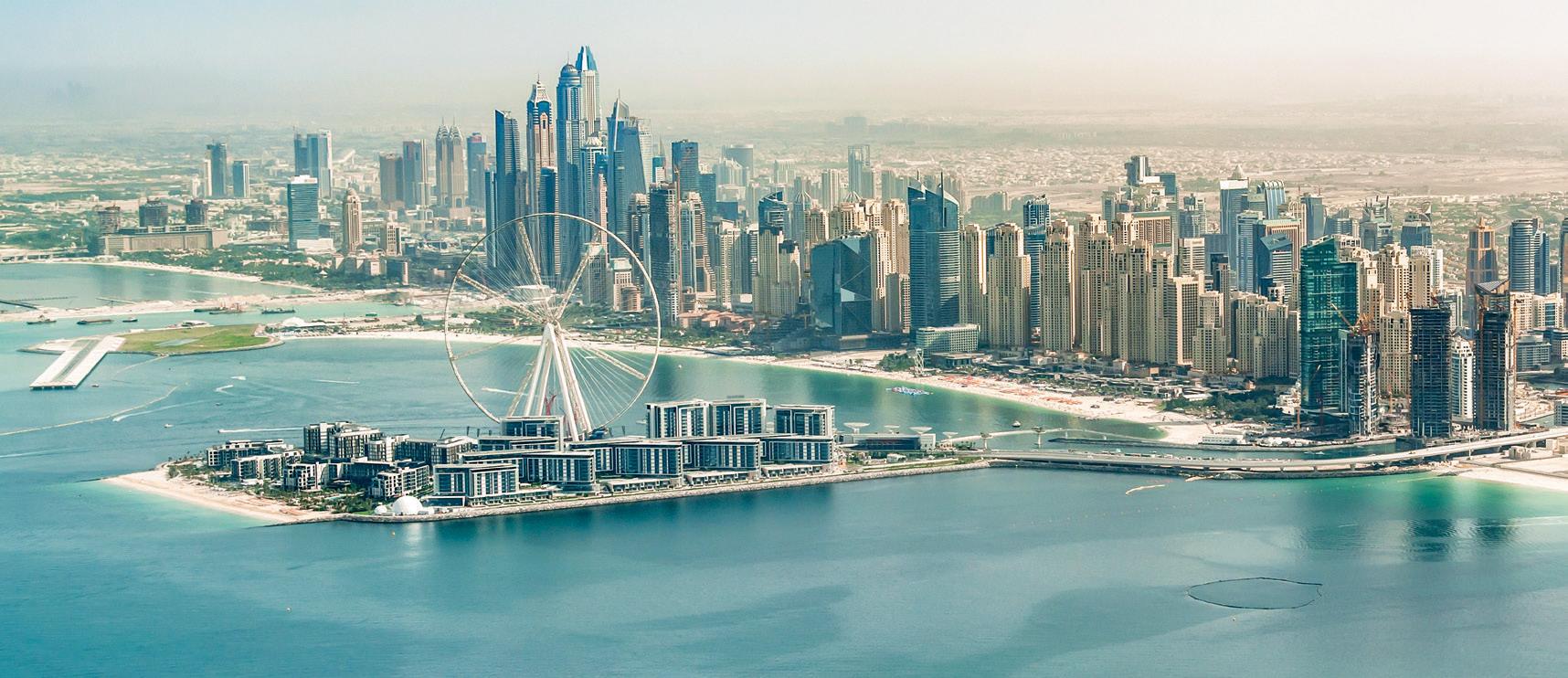

ANALYSIS: 60,440 sales worth $48.2bn were recorded in Dubai during H1 2023
PROPERTY
Final phase of Arada’s Masaar residential project launches
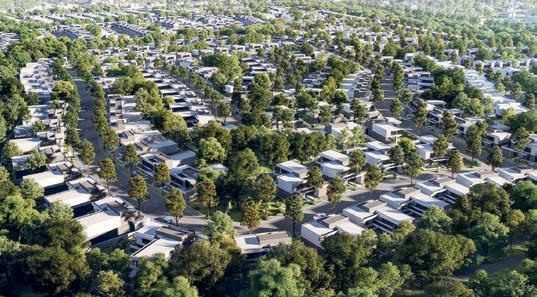
EVENTS: Construction Intel Summit KSA to return to Riyadh on 17 October


6 ONLINE August 2023 | MEConstructionNews.com LATEST NEWS
INDUSTRY
REGISTER NOW 06 September 2023 Habtoor Grand Resort JBR
Kingspan Group acquires majority stake in Steico SE
CONSULTANT
‘Dubai Sustainable Tourism Stamp’ for hotels

New initiative aligns with UAE’s NetZero 2050 and empowers tourism sector to embrace sustainable goals

CONSTRUCTION
Kezad set to upgrade vital economic zone

AED55m project will transform road and infrastructure network for Kezad Musaffah district
MACHINERY
Search for critical materials in Arabian shield could start in September
Ma’aden and Ivanhoe Electric searching region the size of Switzerland with rich potential for critical minerals and possibly lithium
TECHNOLOGY
MoU signed to develop digital infrastructure hub in King Abdullah Economic City Major multi-party deal will position the city as a key hub for smart connectivity and mobile, data & voice services
MOST POPULAR
PROPERTY
Dubai Properties launches Mudon Al Ranim
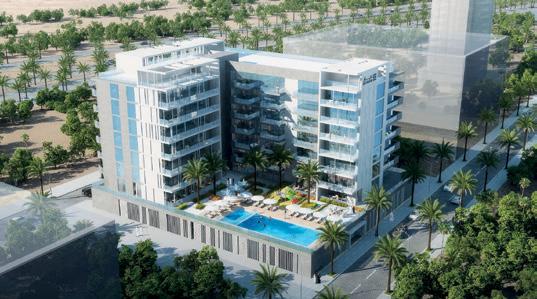
CONSTRUCTION
Aldar to redevelop two major malls

PROPERTY
Deyaar mobilises construction works at Al Furjan site
ENERGY
Acwa Power to deliver major wind plant in Egypt

Project will save 25 million tonnes of annual emissions and provide electricity to 11 million households
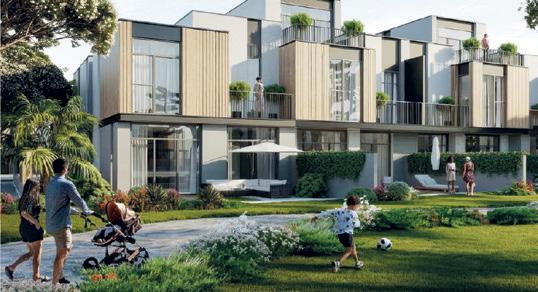
CONSTRUCTION
SSH announces completion of works on Kuwait’s Al Khiran Mall

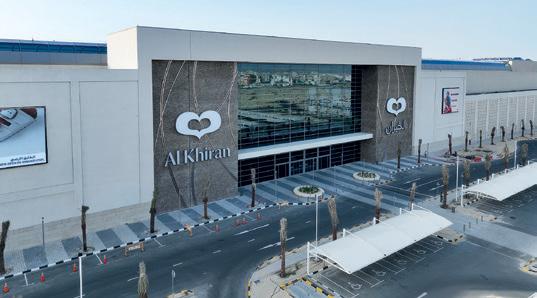
ENERGY
Rawabi Energy closes $1.9bn syndicated deal

MEConstructionNews.com | August 2023 7 ONLINE
FEATURED NEWS
REGISTER NOW 26 September 2023 Habtoor Grand Resort / Dubai
Cutting-edge technology is transforming the delivery and sustainable operation of regional megaprojects
Waste-to-Energy
Dubai Waste-toEnergy facility achieves first fire milestone
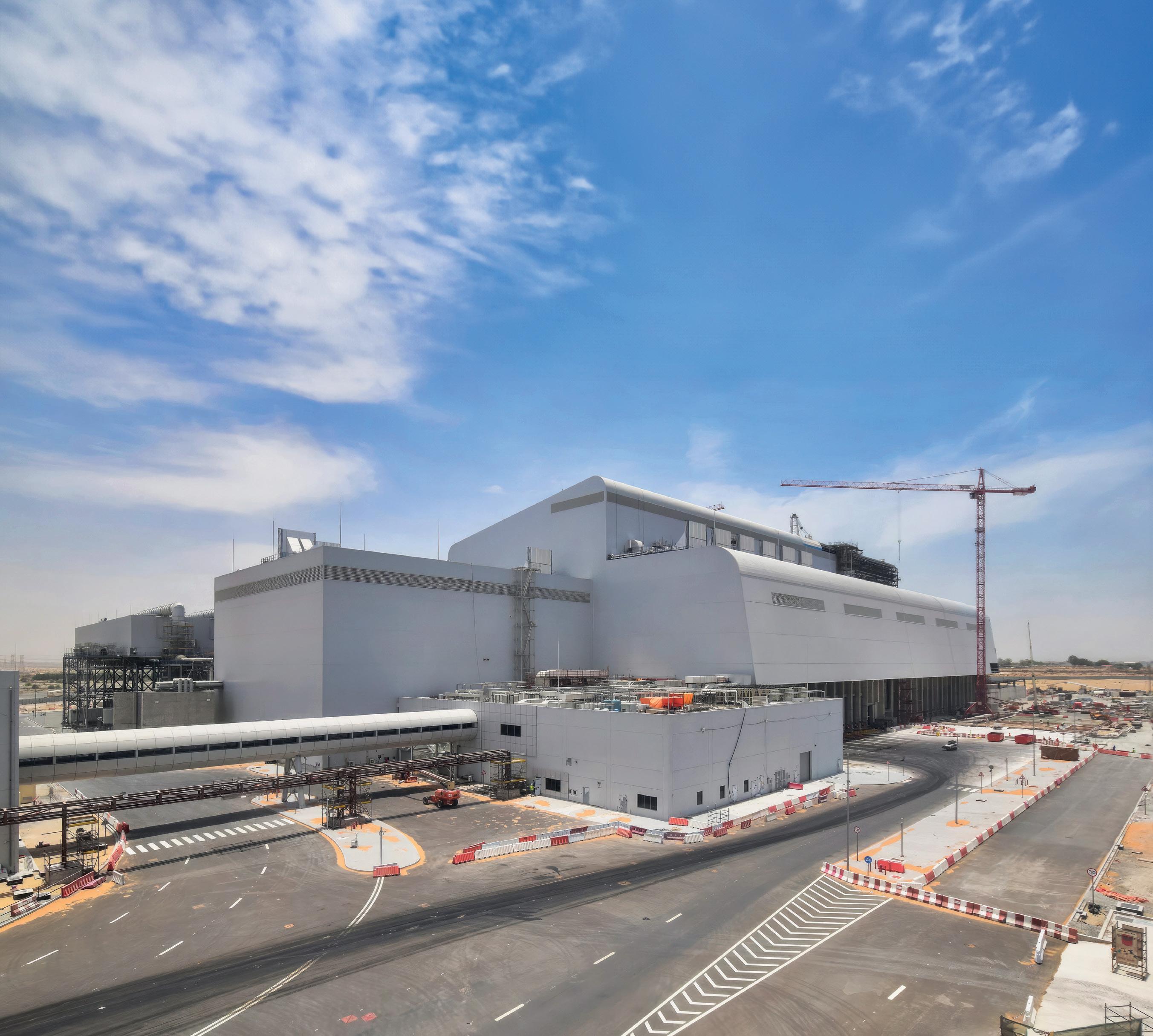
MIDDLE EAST
Several firms are involved in the DWE project including BESIX, HZI, Dubai Holding, DUBAL, Tech Group and ITOCHU
Asignificant milestone in the Dubai Waste-toEnergy (DWE) project has been achieved according to BESIX and Hitachi Zosen Inova (HZI). The successful ignition of the first fire at the DWE facility is said to represent a crucial step towards completing and operating the plant, and demonstrating the efficient and safe processing of waste to generate renewable energy.
The DWE facility is billed as the world’s largest and most efficient waste-to-energy facility, and aims
to reduce landfill dependency and help Dubai achieve its goal of 75% waste diversion by 2025. Currently in its commissioning phase, the DWE facility processes 1,000t of waste daily. Energy production on two lines is set to commence in August 2023; the project aims to be fully operational across all five lines in Q1 2024.
The first fire milestone was witnessed by His Highness Sheikh Hamdan bin Mohammed bin Rashid Al Maktoum, Crown Prince of Dubai, and Chairman of Dubai Executive Council. The visit underscores the
August 2023 | MEConstructionNews.com 8
THE BRIEFING
75% The facility aims to help Dubai achieve 75% waste diversion by 2025
project’s importance and serves as a testament to Dubai’s commitment to sustainability, innovation, and the pursuit of excellence.
Several firms are involved in the DWE project, including BESIX, HZI, Dubai Holding, DUBAL, Tech Group and ITOCHU. BESIX was said to have been chosen for the project due to its expertise in complex infrastructure projects, and plays an integral role in the DWE project. The firm is responsible for overseeing civil, infrastructure, fire-fighting, and ancillary works. Meanwhile, HZI led process-related work, and leveraged its technology offering and expertise to convert municipal solid waste efficiently and safely into clean energy.
“We are immensely honoured to have His Highness witness the
successful ignition of the first fire. This momentous achievement was made possible by the efficient collaboration between BESIX and HZI, along with Dubai Holding, DUBAL, Tech Group, and ITOCHU. All parties take great pride in working together towards our shared objective,” said Benoit Vadani, Vice-President, Director Development at BESIX.
At its peak, the plant will process 5,666t of waste daily, equivalent to two million tonnes annually. This will generate 220MW of electricity, supplying power to roughly 135,000 homes. From the residual ash produced during combustion, metals will be recovered and recycled for commercial use, a statement explained.
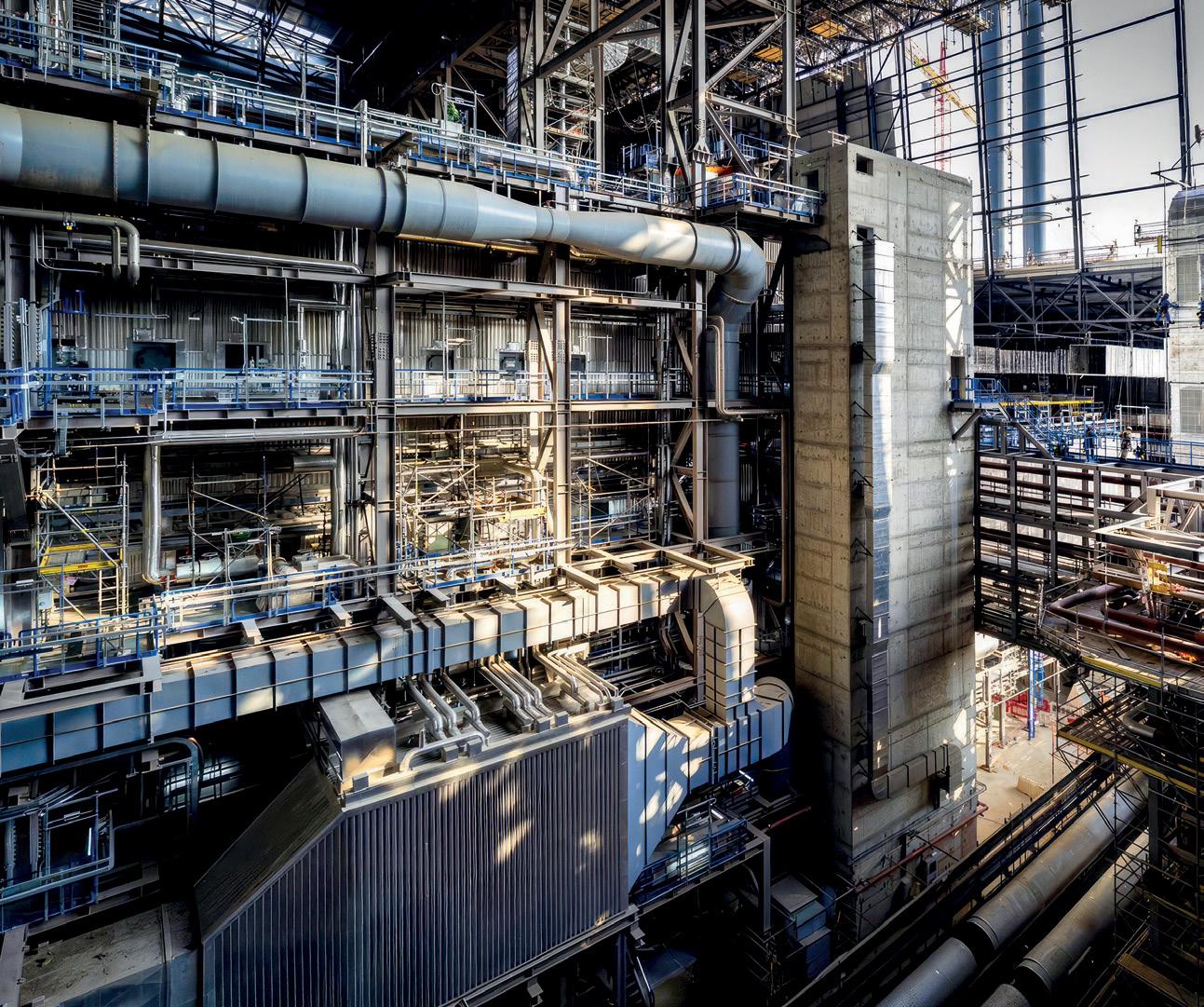 Roni Araiji, Managing Director Middle East, Hitachi Zosen Inova
Roni Araiji, Managing Director Middle East, Hitachi Zosen Inova
added, “HZI stands as a global leader in sustainable energy and environmental solutions. This facility represents a remarkable collaboration to tackle pressing waste management challenges and generate clean energy for the region. The successful ignition of the first fire serves as a testament to our system’s capability to convert waste efficiently and safely into renewable energy.”

The facility’s construction is said to adhere to the highest international standards of engineering, efficiency, and environmental sustainability.
Once the project has been completed, a joint venture between HZI and BESIX will provide operation and maintenance services for 35 years, under an agreement with Dubai Municipality, BESIX concluded.
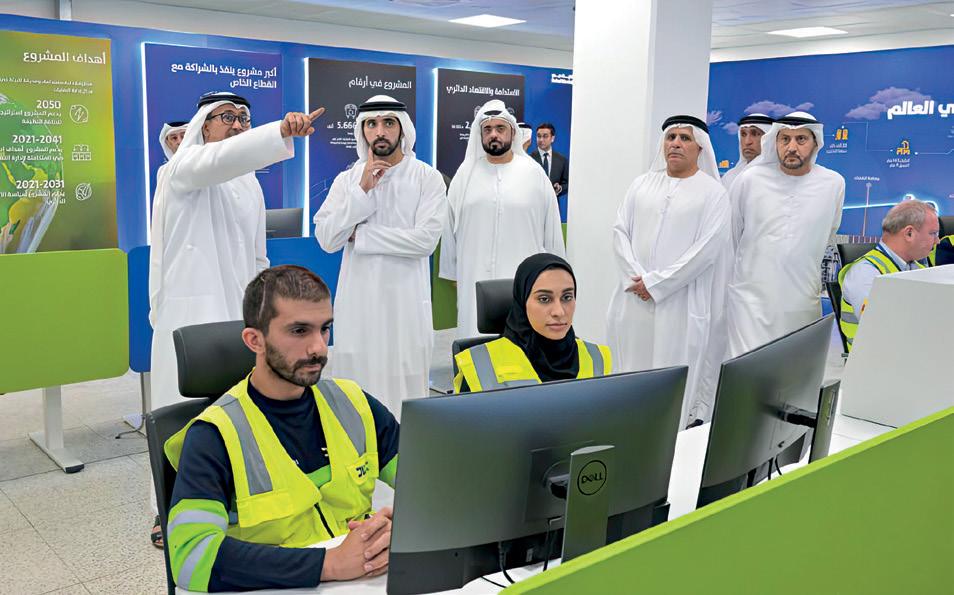

9 MEConstructionNews.com | August 2023 THE BRIEFING
Long-term commitment Once completed, a JV between HZI and BESIX will provide operation and maintenance services for 35 years under an agreement with Dubai Municipality.
5,666
At its peak, the plant will process
5,666t of waste daily
Taweelah RO surpasses 90% production capacity
EWEC (Emirates Water and Electricity Company) has announced that the production of desalinated water using low-carbon intensive reverse osmosis (RO) technology from the Taweelah Reverse Osmosis (RO) facility has surpassed 90% capacity, producing 183 million imperial gallons per day (MIGD), equivalent to 831,935cu/m per day, of desalinated water. This is said to make the Taweelah RO facility the world’s largest operating RO plant.
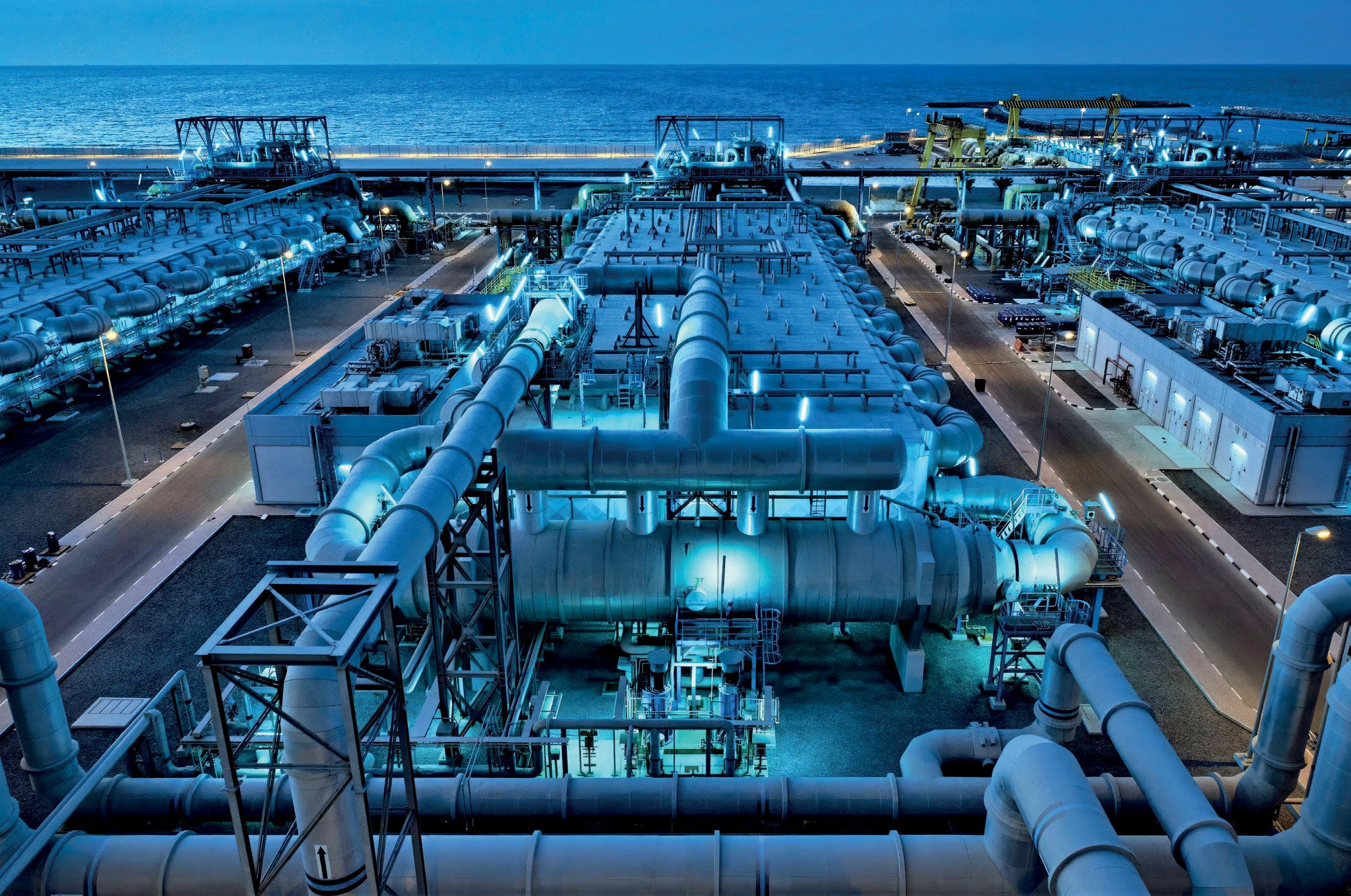
When it reaches full operational capacity, Taweelah RO will supply 200MIGD, equivalent to 909,200cu/m per day of potable water.
EWEC, which is focused on the planning, purchasing and supply of water and electricity across the UAE, notes that the adoption of low-carbon intensive RO water desalination technology is a key pillar
of its strategic initiative to decouple water and power generation.
RO technology increases energy efficiency by 96% when compared to traditional thermal desalination plants and reduces carbon emissions by more than 85%, the firm explained.
The Taweelah RO facility is owned by TAQA Group (20%), Mubadala (40%) and ACWA Power (40%), with EWEC procuring the water from Taweelah RO for the next 30 years as part of a Water Purchase Agreement signed in 2019.
“Taweelah RO is part of EWEC’s strategic shift of its water and power generation portfolio, supporting the decarbonisation of the energy sector in line with the UAE Net Zero by 2050 strategic initiative. We are proud of the collaboration with our partners that has enabled Taweelah RO to reach over 90% of its water production capacity, making Taweelah RO the world’s largest commercially operating reverse osmosis
August 2023 | MEConstructionNews.com 10
At its current capacity, the reverse osmosis desalination facility is said to be the largest commercially operating RO facility in the world
UNITED ARAB EMIRATES
THE BRIEFING
desalination facility,” stated Othman Al Ali, Chief Executive Officer of EWEC.

“We plan an additional 290MIGD of new reverse osmosis production capacity by 2027, and by 2030, 90% of all water desalination will be produced using reverse osmosis, enabling an 88% reduction in our carbon emissions associated with water production. EWEC’s strategic investments in worldclass, utility-scale transformative reverse osmosis water desalination facilities are enabling Abu Dhabi and the UAE to accelerate its journey into the next chapter of sustainability,” he explained.
A major strategic pillar for the long-term decarbonisation of the water and energy sectors, low
carbon-intensive water desalination is crucial to meeting the water demands of Abu Dhabi and the UAE, while significantly reducing carbon emissions, EWEC said in a statement.

Taweelah RO is EWEC’s fourth operational desalination plant with RO capacity, joining Mirfa 1, and the Fujairah F1 and Fujairah F2 hybrid water desalination and power plants. EWEC said that it has also commissioned the development of four additional low-carbon intensive water production facilities, including Mirfa 2 RO, Shuweihat 4 RO, and two standalone RO water desalination plants as part of the Abu Dhabi Islands RO Independent Water Project.
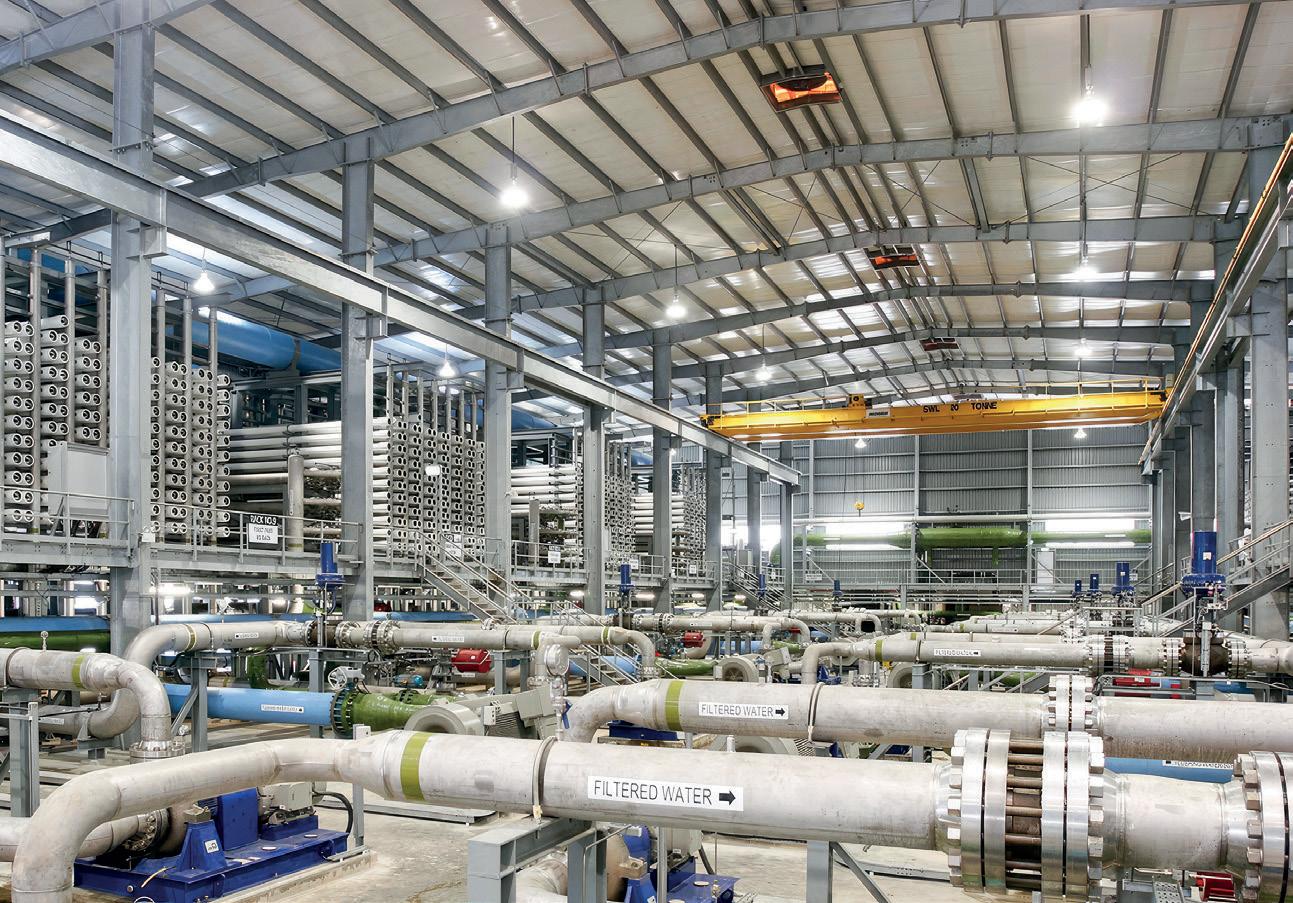
11
MEConstructionNews.com | August 2023 THE BRIEFING
Key facility When it reaches full operational capacity, Taweelah RO will supply 200MIGD, equivalent to 909,200cu/m per day of potable water.
Taweelah RO
Meeting demand Low carbon-intensive water desalination is crucial to meeting the water demands of Abu Dhabi and the UAE, while significantly reducing carbon emissions says EWEC.
is part of EWEC’s strategic shift of its water and power generation portfolio, supporting the decarbonisation of the energy sector in line with the UAE Net Zero by 2050 strategic initiative”
01 UNITED STATES
‘130 William’ tower complete in New York
The ‘130 William’ tower has been completed in Manhattan. The 66-storey residential tower is Adjaye Associates’ first project in the United States.

It contains 242 residences, two retail floors, a health club, fitness centre, cinema, outdoor terraces, rooftop observatory deck, and new public plaza park.
“Conceived as an urban living room, the public plaza park is fundamental to how one experiences 130 William. The plaza creates a public amenity and a transitional moment between the bustle of the city and the respite of the private residences inside,” stated David Adjaye, Founder and Principal of Adjaye Associates.
02 PANAMA Sener wins contract for new bridge

The contract to design a fourth bridge over the Panama Canal has been awarded to Sener. The project scope covers the design and construction of a six-lane bridge that will cross the canal between Panama West and Panama City, in a bid to lighten traffic in those areas.
The main elements of the bridge include the two complex interchanges at either side of the canal, as well as their respective double-decker access viaducts, with a total length of 2,450m, and the main cable-stayed bridge with a total length of 965m, a main span of 485m and a vertical clearance for passing ships of 75m.
Acwa Power to deliver wind plant in Egypt
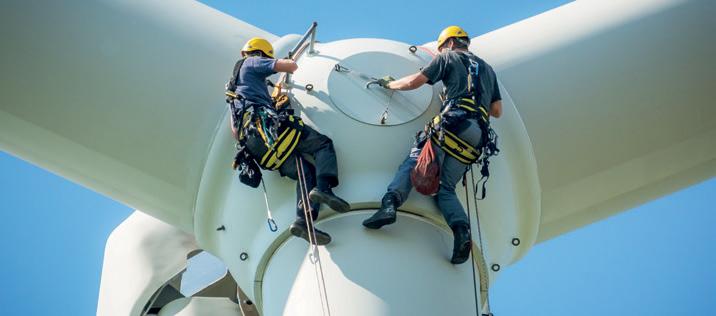
Acwa Power has signed an agreement with Egypt’s NREA to construct a 10GW wind project near the city of Sohag.
The power plant is expected to provide the Egyptian economy with annual savings of US $6.5bn in natural gas costs – as well as securing up to 120,000 job opportunities. Under the deal, NREA will allocate approximately 3,000sqkm of land.
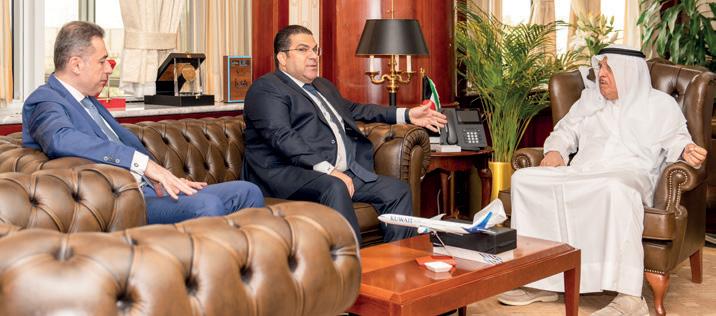
On completion, the project is expected to generate 50,000GW-hours of clean energy annually, providing electricity to around 11m households and mitigating the impact of 25.5m tonnes of carbon emissions each year.
‘Route of Development’ project to be overseen by special group
According to Shada Radi, spokesperson for the Iraqi Ministry of Transport, a special group has been established to oversee the implementation of a project to build 1,200km of road and rail infrastructure that will link the country to Europe and other countries in the Middle East.
Once complete, the US $16.9bn project will run from Iraq’s northern border with Turkey to the southern Gulf region. The plan comprises the construction of approx 15 stations along the route, including major cities such as Basra, Baghdad, Mosul, and locations up to the Turkish border.
03 NIGERIA Mota-Engil wins $920.05mn rail project contract in Nigeria

Construction specialist Mota-Engil has been awarded a US $920.05mn contract to provide and finance railway rolling stock in Nigeria.

The contract is said to be a significant part of a larger rail project valued at $2bn that aims to connect Nigeria with Niger. The 284km railway track will run between Kano, the capital of the northern state of Kano, and Maradi, the second largest city in Niger, and the centre of the country’s developing oil industry. It will also run east from Kano to Dutse, the capital of Jigawa State.
06
Egis to deliver PMC services for Kuwait Airways Tower project
A PMC services contract for the new Kuwait Airways Tower project in Qibla, Kuwait has been awarded to Egis.
As per Egis, Kuwait Airways Company (KAC) aims to construct a state-ofthe-art, LEED certified, multi-purpose tower that adheres to the latest technical and professional standards, optimising functionality and sustainability.
Egis said it will work closely with KAC alongside the entire project lifecycle, providing comprehensive project management services from pre-design to testing, commissioning, and handover.
12 August 2023 | MEConstructionNews.com 01 02
04 EGYPT
KUWAIT
THE BIG PICTURE
05 IRAQ
SAUDI ARABIA
Floating desalination barges deployed by SWCC
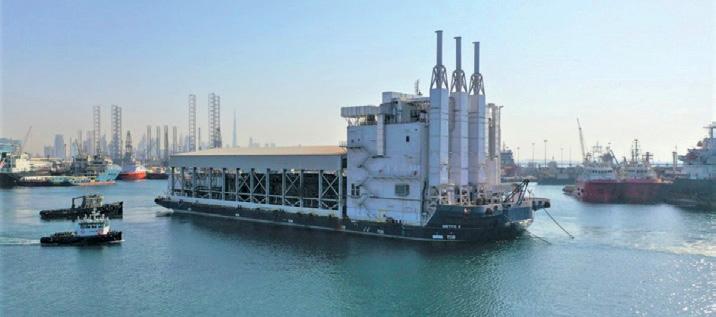
The Saline Water Conversion Corporation (SWCC) has deployed desalination barges to meet demand for potable water during the Hajj season in Makkah and Madinah. With over 1.6m pilgrims having arrived in Saudi Arabia, the mobilisation ensured the uninterrupted supply of potable water.
Metito engineered, designed, developed, and commissioned the floating desalination barges for its client, the Saudi National Shipping Company. Three barges, 50,000m3/d each, secured the project the title of the largest operating plant of its kind in the world.
Doka completes works for bridge in India
Doka India has completed formwork and engineering on the construction of a 900m central cable-stayed bridge in Dwarka, India. The bridge has a total length of 2.5km and will comprise four lanes, measuring 29.6m in width. The project’s scope also includes 3.5km of retaining walls and 1.42km of approach on each side.

The bridge features the largest span of any cable-stayed bridge in India, with a total length of 500m between the two pylons. The structure is supported by 76 cables, and the most challenging aspect of the project was designing the curved pylons, which are inclined at 20.1 degrees at the centre, 22.6 degrees to the left, and 19 degrees to the right.
09
C&D and Conares expand distribution of Chinese steel

A new partnership between C&D and Conares should provide the GCC with access to a wide range of top-grade Chinese steel products in industries, including construction, infrastructure development, and manufacturing.
The “groundbreaking collaboration will empower” the Chinese corporation to distribute high-quality steel from China in the GCC region, strengthening trade ties between them, they said in joint statement.
The official signing of the partnership took place at Conares’ state-of-the-art steel plant in the Jebel Ali Free Zone (JAFZA) in Dubai.
13 MEConstructionNews.com | August 2023
CHINA
08 INDIA
THE BIG PICTURE 03 04 05 09
07
07 06 08
A strong showing in Q2
UNITED ARAB EMIRATES
The delivery of 7,300 units in Dubai during the second quarter raised the total residential stock to 700,000 units. In the remaining half of this year, an additional 21,000 units are scheduled to be handed over. In Abu Dhabi, about 1,000 units were added during the quarter, bringing the total residential stock to 283,000 units.
In terms of future supply, close to 3,000 units are in the pipeline for this year, comprising mainly of apartments within master planned communities such as Al Raha Beach, Al Maryah Island and Al Reem Island.
Several developers reported robust absorption of newly launched projects in Dubai. According to data from Dubai Pulse, off-plan residential sales increased by 38% in value and 30% in volume during Q2, when compared to the same period last year. The majority (57%) of the transactions in the off-plan category were recorded between US $136,000 and $544,000, with investors primarily focused on studios and 1BR units in areas like JVC, Dubailand and MBR City.
Similarly, in Abu Dhabi, the off-plan market continued its strong performance over the quarter. Data from Quanta showed that off
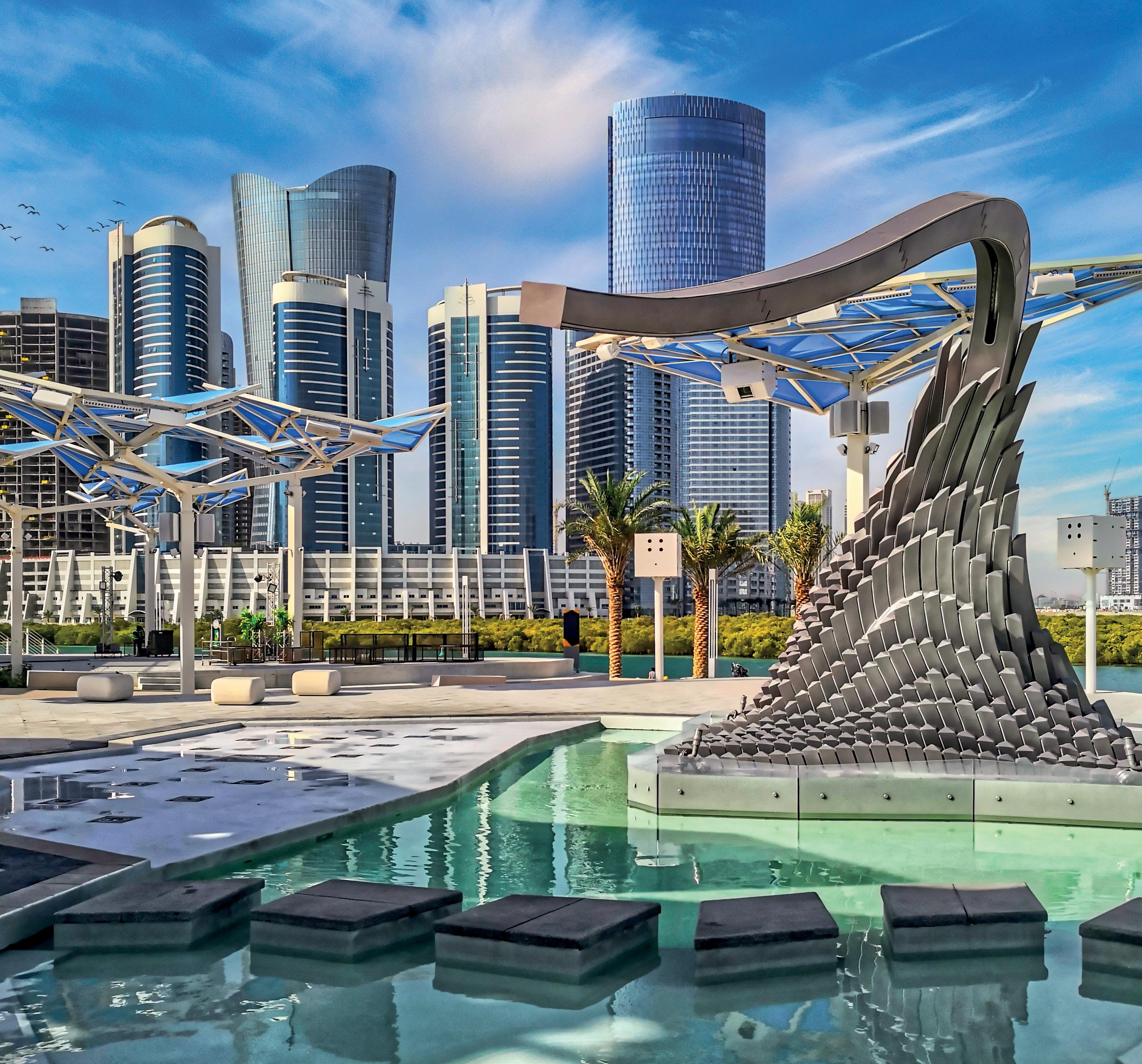
14 August 2023 | MEConstructionNews.com
JLL’s Faraz Ahmed discussing the supply and performance of Dubai & Abu Dhabi’s residential, office and hospitality spaces in Q2, 2023
MARKET REPORT Industry Outlook
plan transactions value more than doubled from $490mn in Q2 2022 to $1bn in Q2 2023. Activity was largely concentrated between the $544,000 and $817mn range, driven by villa transactions on Al Reem Island and Yas Island. Residential market performance continued to surge in Dubai, with a 16% uptick in sale prices and 24% in rentals in May 2023, when compared to the same period last year. The demand for high quality luxury products persisted in established mixed-use communities. In the capital, sale prices and rentals were marginally up by 1% each, as outdated stock on the main island continued to face pressure from newer high-end communities. This trend is likely to persist as the emirate continues to draw demand towards upcoming new islands.
COMMERCIAL MARKET
During the second quarter, there were no office projects completed in either Dubai or Abu Dhabi, keeping the total supply stable at 9.1m sqm in Dubai and 3.9m sqm in the capital. Over the remaining half of 2023, around 99,000sqm of office gross leasable area (GLA) is expected to enter Dubai and 41,000sqm in Abu Dhabi. Dubai’s office market continued to record strong demand, with a diverse mix of tenants
from all segments. Due to the low availability of good-quality office space and the healthy inflow of new market entrants, co-working and serviced offices have acted as an initial landing pad for the majority of new entrants, while they explored long-term options. Consequently, average Grade A rents within the Central Business District (CBD) increased by 18% yearon-year (Y-o-Y) to $626 per sqm per annum in the second quarter. For the same period, office vacancy within the CBD was recorded at 10%. Similarly, in Abu Dhabi, the number of office inquires, and the amount of space being sought have both increased over the past quarter, primarily driven by the defence, technology, and financial industries. Demand for Grade A space continued to increase due to limited availability.
As a result, average citywide Grade A rents rose by 11% Y-o-Y to $517 per sqm per annum in Q2. Additionally, the demand for co-working and serviced offices also stayed strong as corporates continued to follow hybrid working models.
Occupiers are being compelled to change their strategy while finding new space, due to rising rents and limited availability in prime locations. While some opted to reassess their requirements and settle for what was available in the market, others had to expand
their search to secondary locations offering Grade B/B+ spaces. Occupiers with more stringent requirements are having to explore built-to-suit opportunities to fit their needs.
RETAIL MARKET
Around 6,000sqm of retail space was added in Dubai during the second quarter, increasing the stock to 4.7m sqm. In the remaining months of this year, around 83,000sqm of retail GLA is scheduled to be delivered across the emirate, the majority of which is in the form of expansion of a super regional mall and new neighbourhood malls. In Abu Dhabi, about 2,000sqm of retail space was completed, which raised the total stock to 3.1m sqm. Another 58,000sqm is anticipated to be completed in the second half of this year.
Well-located retail developments have been benefitting from the increasing number of tourists in Dubai. Prime retail developments were operating at near full occupancy. In contrast, community malls and retail developments in secondary locations noted a marginal drop in activity, as footfall remained dominant in larger regional and super- regional malls. As a result, average rental values across primary and secondary
15 MEConstructionNews.com | August 2023 MARKET REPORT
Source: STR Global, REIDIN
DUBAI
SUPPLY ABU
SUPPLY 700k Total residential stock 21k Expected 2023 deliveries +24% Average rental rates change 283k Total residential stock 3k Expected 2023 deliveries +1% Average rental rates change DUBAI OFFICE SUPPLY ABU DHABI OFFICE SUPPLY 9.1m Total stock (sq m GLA) 99k 2023 deliveries (sq m GLA) +18% Average rental rates change 3.9m Total stock (sq m GLA) 41k 2023 deliveries (sq m GLA) +11% Average rental rates change
Residential market performance continued to surge in Dubai, with a 16% uptick in sale prices and 24% in rentals in May 2023 compared to last year”
RESIDENTIAL
DHABI RESIDENTIAL
malls were down by 2% in Q2 when compared to the same period last year.
In Abu Dhabi, broadly, the retail market maintained stable rental performance over the second quarter when compared to the same period last year. That said, certain landlords, particularly those of old developments, faced pressure due to increased competition from new retail developments. In contrast to Dubai, landlords were more flexible and offered incentives such as providing capex support, honeymoon trade periods, revenue share-based deals, and extended fit-out periods for established international brands.
F&B remained one of the strongest sectors to drive footfall in retail developments. In order to enhance the customer experience and introduce new concepts to the market, mall owners have been exploring plans to upgrade their offerings through either upgrading traditional food courts or adding new modern food halls. One such example is the upcoming “Market Island” in Dubai Festival City. These new food halls are generally designed to attract upper-scale F&B brands.
HOSPITALITY MARKET
In the second quarter, around 1,000 keys were added in Dubai, increasing the total supply
to 151,000 keys. During the same period, no notable hotel projects were completed in the capital, keeping the total stock stable at 32,500 keys. In the remaining six months of this year, another 6,000 and 200 keys are scheduled to be handed over in the former and the latter city, respectively.
After an exceptional last year, Dubai’s hotel market started to show signs of stabilising in Q2 2023. Applying effective revenue management strategies, operators opted to maintain higher occupancies at the expense of average daily rates (ADR).
Indeed, for the period of January through June, ADR decreased by 6% to reach $188 when compared to the same period last year. In contrast, occupancy level increased to 78% for YT June. This decline is by no means a precursor to a slow down but rather a healthy indicator of the market finding its balance.
In Abu Dhabi, the hotel market continued to perform strongly. The emirate aims to achieve a total of 24m visitors by the end of 2023, and the growth in both domestic and international visitors can be credited to greater awareness of Abu Dhabi as a destination, and the availability of a wider selection of year-round entertainment, sporting events, trade events, and roadshows.
For YT June, the capital recorded a 26% increase in ADR to reach $137 when compared to the same period last year. For the same period, citywide occupancy increased to 71%. This resulted in a 28% increase in revenue per available room (RevPar), which stood at $97.
With several modern tech enabled hotels operating, legacy hotels need to undergo renovations to enhance their competitiveness. These refurbishments focus on tech upgrades, sustainability and design enhancements, and aim to align traditional hotels with contemporary industry standards and cater to evolving customer experience.
“In the second quarter, all sectors demonstrated strength and adaptability propelled by new and emerging trends. The continued growth in off-plan transactions, rising demand for quality office spaces, and transformative renovations in the hotel sector, collectively indicate the dynamism of Dubai and Abu Dhabi as vibrant investment destinations,” said Ahmed.
He concluded, “With strong investor confidence, robust absorption of new projects, and innovative developments, there is no doubt that these cities are paving the way for sustained growth and transformation across the entire real estate landscape in the UAE.”
16 August 2023 | MEConstructionNews.com MARKET REPORT
In Abu Dhabi, the hotel market continued to perform strongly. The emirate aims to achieve a total of 24m visitors by the end of 2023”
151k Total hotel keys 6k Expected 2023 deliveries 78% Occupancy YT June 2023 32.5k Total hotel keys 200 Expected 2023 deliveries 71% Occupancy YT June 2023
DUBAI HOTEL SUPPLY ABU DHABI HOTEL SUPPLY
4.7m Total stock (sq m GLA) 83k 2023 deliveries (sq m GLA) -2% Average rental rates change 3.1m Total stock (sq m GLA) 58k 2023 deliveries (sq m GLA) 0% Average rental rates change C M Y CM MY CY CMY K
DUBAI RETAIL SUPPLY ABU DHABI RETAIL SUPPLY

Getting Serious About Sustainability
JASON SAUNDALKAR SPEAKS TO KEO ’S SUSTAINABILITY TEAM ABOUT ACHIEVING NET ZERO IN THE BUILT ENVIRONMENT, THE BENEFITS THE FIRM HAS OBSERVED AS A RESULT OF ITS SUSTAINABILITY STRATEGIES, THE POTENTIAL IMPACT OF COP28, AND WHAT GOVERNMENTS NEED TO ROLL OUT TO USHER IN A NET ZERO FUTURE

18 August 2023 | MEConstructionNews.com IN
KEO
PROFILE


19 MEConstructionNews.com | August 2023
t’s a well-known fact that the building and construction sector accounts for 40% of the annual global greenhouse gas emissions (GHGe). Breaking that figure down, building operations are responsible for 27% annually, while construction practices, materials extraction and manufacturing (embodied carbon) are responsible for an additional 13%.
In addition, according to the IEA Energy Technology Perspectives 2020 report, by 2040 approximately 2/3 of the global building stock will be structures that exist today. This means without significant action to decarbonise existing stock across the globe, the building and construction sector will not be on track to achieve the Paris Agreement’s goal of limiting the rise in global temperature to 1.5-degrees Celsius compared to pre-industrial levels.
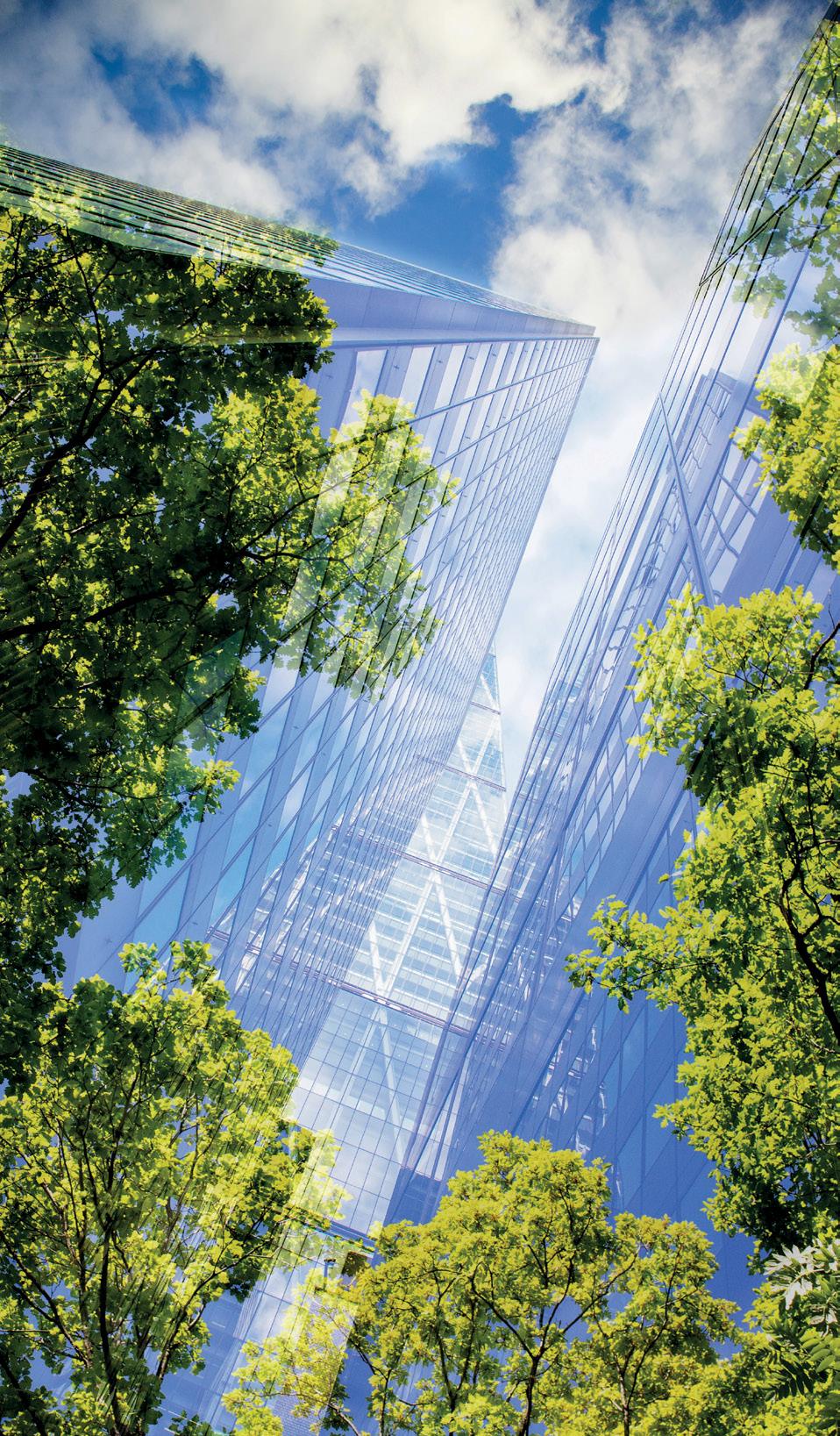
Over the last few years, an awareness about the need to limit GHGe across the sector is continuing to grow. KEO has, over the past several years, taken major steps to decarbonise with regards to its projects and has a fullyfledged Net Zero strategy in place.
Here, Jason Saundalkar speaks to KEO’s sustainability team in the UAE about the firm’s approach to sustainability and achieving Net Zero in the built environment.
Asked to outline key points of the strategy pertaining to buildings and infrastructure, KEO’s sustainability team notes, “The industry faces both opportunities and challenges in its quest for a Net Zero carbon future by 2050. At KEO our approach starts with proactive communication with our clients and stakeholders to fully understand their decarbonisation plans and pathways. Collaboration and thorough discussion are important elements, given the paradigm shift needed to deliver projects which achieve long-term sustainability targets.”
“Drawing upon our extensive experience, KEO has developed numerous Net Zero strategies, enabling us to identify common steps that can be customised to align with the unique purpose and requirements of each project. We focus on understanding how the real estate or infrastructure asset needs to operate to achieve maximum efficiency during their operation and full lifespan. We then focus on maximising efficiency in design and construction using our comprehensive understanding of the entire process and utilising the latest digital technology platforms.”
KEO’s experts say that the firm leverages proprietary digital tools such as iCRBN for assessing citywide strategies and measuring on-site emissions and the environmental aspects of projects respectively.
“To minimise the carbon footprint of our projects, we focus on implementing passive cooling design measures and optimising the asset’s energy performance. Also, we consider materials with low embodied carbon in our design,” the team explains.
Discussing where opportunities lie and highlighting positive results the firm has tracked as a result of its strategy
and techniques, the team comments, “The pursuit of Net Zero carbon in real estate and infrastructure projects presents numerous opportunities for positive change across various design dimensions, as teams work collectively to increase efficiencies and drive impactful transformations. Positive results include reduced project life cycle costs, reduced energy costs and increased carbon savings. In many new projects, we have provided strategies towards decarbonisation, which have resulted in projected energy and carbon reduction of 35% to 55%, compared to similar conventional buildings of a similar budget.”
“For more advanced Net Zero interventions, we have developed ‘blueprints’ with the net energy reduction being equal to 85% - 100%. By optimising solutions, we also see improved indoor air quality, and other enhancements in quality of life,” KEO’s sustainability experts point out.
“Consideration of compact and human-centred designs can create environmentally friendly cities with an overall low footprint. Remodelling and retrofitting existing assets - especially those that are considered ‘stranded assets’ - can be a cost-effective way to reduce carbon emissions and increase the valuation of the asset. The shift towards low embodied carbon materials and lower energy consumption construction practices can benefit the environmental conditions of the wider industry.”
Outlining the roadblocks that they see with regards to achieving Net Zero across buildings and infrastructure in the Middle East, KEO’s sustainability team explains, “In many cases, projects’ budgets limit the willingness for decarbonisation, however, we are seeing green financing becoming more readily available. As a LEED Proven Provider for the BD+C rating system family, KEO has the experience to deliver such buildings. Similarly, for infrastructure projects under ENVISION and BRE Infrastructure certifications.”
The team outlines that there are several technical approaches that can be employed today; comprehensive operational modelling at the start of the concept design stages can play a crucial

20 August 2023 | MEConstructionNews.com
IN PROFILE
Getting results KEO has provided strategies on decarbonisation on several projects, which have resulted in projected energy and carbon reduction of 35% to 55%, compared to similar conventional buildings of a similar budget.
40% The builtenvironment is responsible for 40% of all annual global greenhouse emissions
role in identifying areas of improvement in both infrastructure and buildings.
“Through KEO workflows and by using integrated design solutions, we find opportunities to optimise a building’s electromechanical systems and infrastructure operational requirements and regimes. We recognise the value of BIM, in enabling accurate modelling of spaces and environments, which helps in accurate performance simulations, ensuring that infrastructure projects and new and retrofitted buildings have optimised operational strategies, processes, and spaces. With the move towards Digital Twins, we can now access live data from operational sensors to enable real-time issue identification and an almost automatic optimisation of energy performance. Finally, we have noticed that sharing best practices and case studies can be a catalyst for driving innovation and inspiring clients to pursue low emissions, high positive impact projects,” says the team.
2040
COMING TOGETHER AS A SECTOR
While built environment stakeholders have taken steps to decarbonise and achieve Net Zero, global events such as COP28 could potentially rally efforts across the sector.

Sharing expectations in terms of the impact COP28 may have on the built environment, KEO’s experts state, “COP28 can have a profound impact on the built environment in the UAE and the wider region. We look forward to seeing international cooperation, and further commitments of nations to more ambitious targets, with specific policies, and strategies for achieving Net Zero carbon emissions goals.”
“We also want to see the adoption of significant policy decisions, providing frameworks for policymakers and developers to implement measures promoting sustainable buildings and infrastructure. It will also be interesting to see how COP28 can scale up financing for sustainable projects, supporting
21 MEConstructionNews.com | August 2023 IN PROFILE
By 2040 nearly 2/3 of the global building stock will be structures that exist today
The pursuit of Net Zero carbon in real estate and infrastructure projects presents numerous opportunities for positive change across various design dimensions, as teams work collectively to increase efficiencies and drive impactful transformations”
Pursuing sustainable outcomes
KEO’s Sustainability team: Gregory Dode, Khader Ghazal, Eoin Sheridan, Loubna Haddad (left to right).
new and existing cities, developers, and suppliers to implement more impactful measures, promoting better lifestyles, and having a Net Zero-carbon supply chain, the latter at least within the medium to long term period. COP28 has great potential to provide significant progress in comparison to COP26 and COP27 by supporting further advancements in sustainable projects through collaboration, the push of technological innovation, and wider public involvement and engagement.”
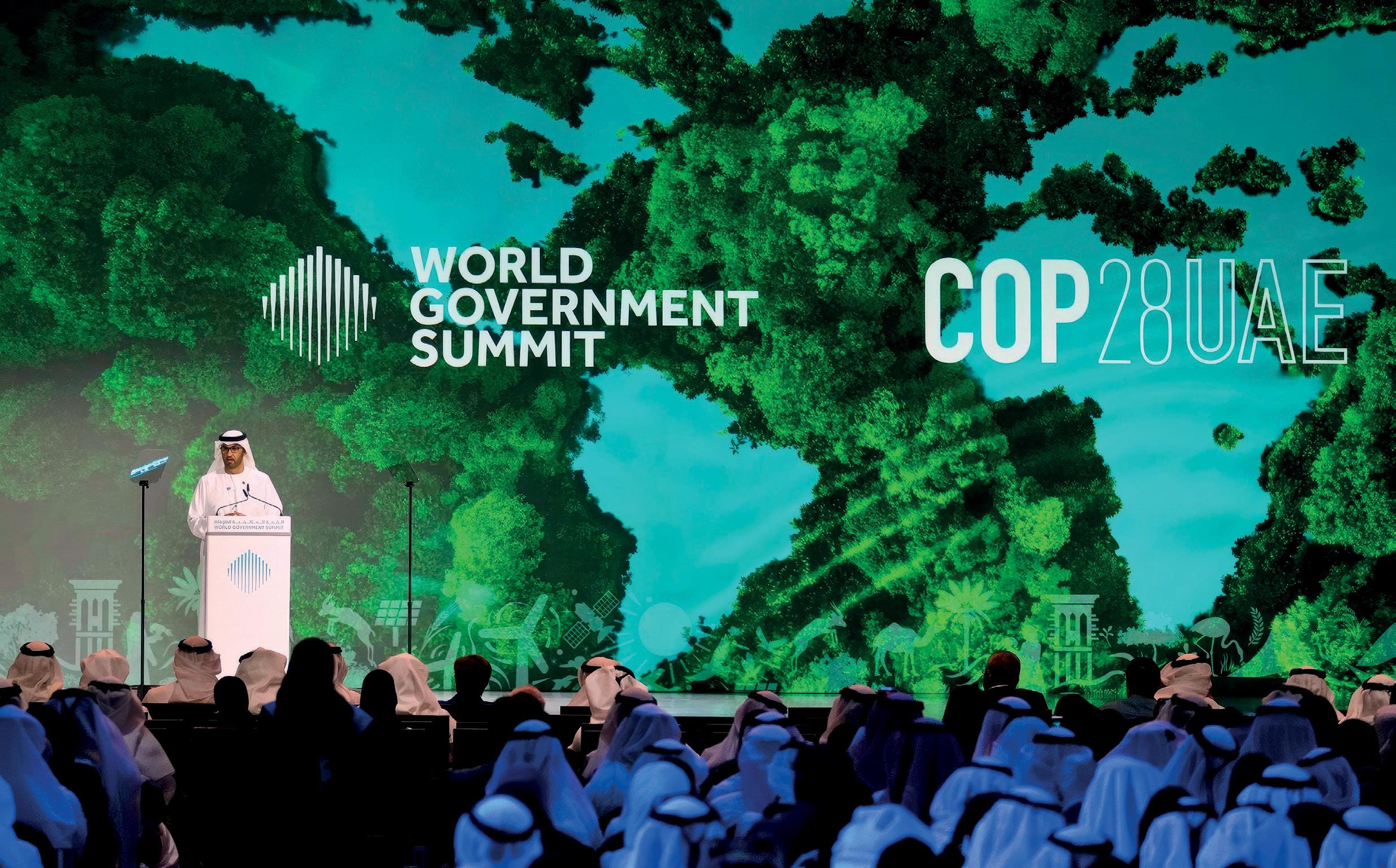
While much has already been done to decarbonise the built environment across the globe, there are still several critical issues that the sector must urgently address in the near term. In fact, the team notes that construction stakeholders should come together around two main issues: the integration of technical expertise and innovative financing mechanisms. They add that KEO is well-equipped to provide support in both areas.
2050
“Collaboration is essential in orchestrating efforts among parties such as consultants, architects and engineers, contractors and developers, especially when the focus is on technical delivery and the achievement of highly rated projects under LEED or ENVISION and BRE Infrastructure certifications. We are actively engaged in delivering such projects, and we have developed a clear and effective approach to achieve these goals. By adopting a collaborative approach, sustainable solutions can be comprehensively integrated into every stage of a project, from its inception to financing and actual delivery. KEO has successfully utilised Integrated Design Process (IDP) principles in highly sustainable projects, achieving a high success rate.”
“Additionally, we have witnessed the emergence in the market of specialised financial instruments aimed at supporting sustainable initiatives. These include green bonds, high-ranked
22 August 2023 | MEConstructionNews.com IN PROFILE
To keep global warming to no more than 1.5°C, emissions need to reach net zero by 2050
COP28 has great potential to provide significant progress in comparison to COP26 and COP27 by supporting further advancements in sustainable projects through collaboration, the push of technological innovation, and wider public involvement and engagement”
Key event COP28 could have a profound impact on the built environment in the UAE and the wider region.
sustainability certification linked loans, corporate sustainable financing, and some impact investment funds. However, accessing financing instruments typically adds an additional level of environmental, social, and governance (ESG) due diligence, which is relatively new to the Middle East construction sector. KEO is currently supporting its clients in aligning with international financing institution requirements such as the International Finance Corporation Performance Standards and Equator Principles, readying them for future investment should the opportunity arise.”
KEO’s sustainability team says, “By combining technical proficiency and financial needs compliance in early project discussions, the widespread adoption of Net Zero carbon projects can be facilitated, expediting the transition toward long-term sustainability targets.”
The built environment comprises complex supply chains, which are essential to delivering buildings and infrastructure and, as a result, it’s critical that they also decarbonise and join in the pursuit for Net Zero. In this respect, there are several challenges including the reduction of embodied carbon emissions of concrete.
Chasing a Net Zero future
Several Middle Eastern countries have unveiled ambitious Net Zero targets including the UAE, which as part of its UAE Net Zero 2050 initiative, aims to be the first country in the MENA region to achieve Net Zero by 2050.
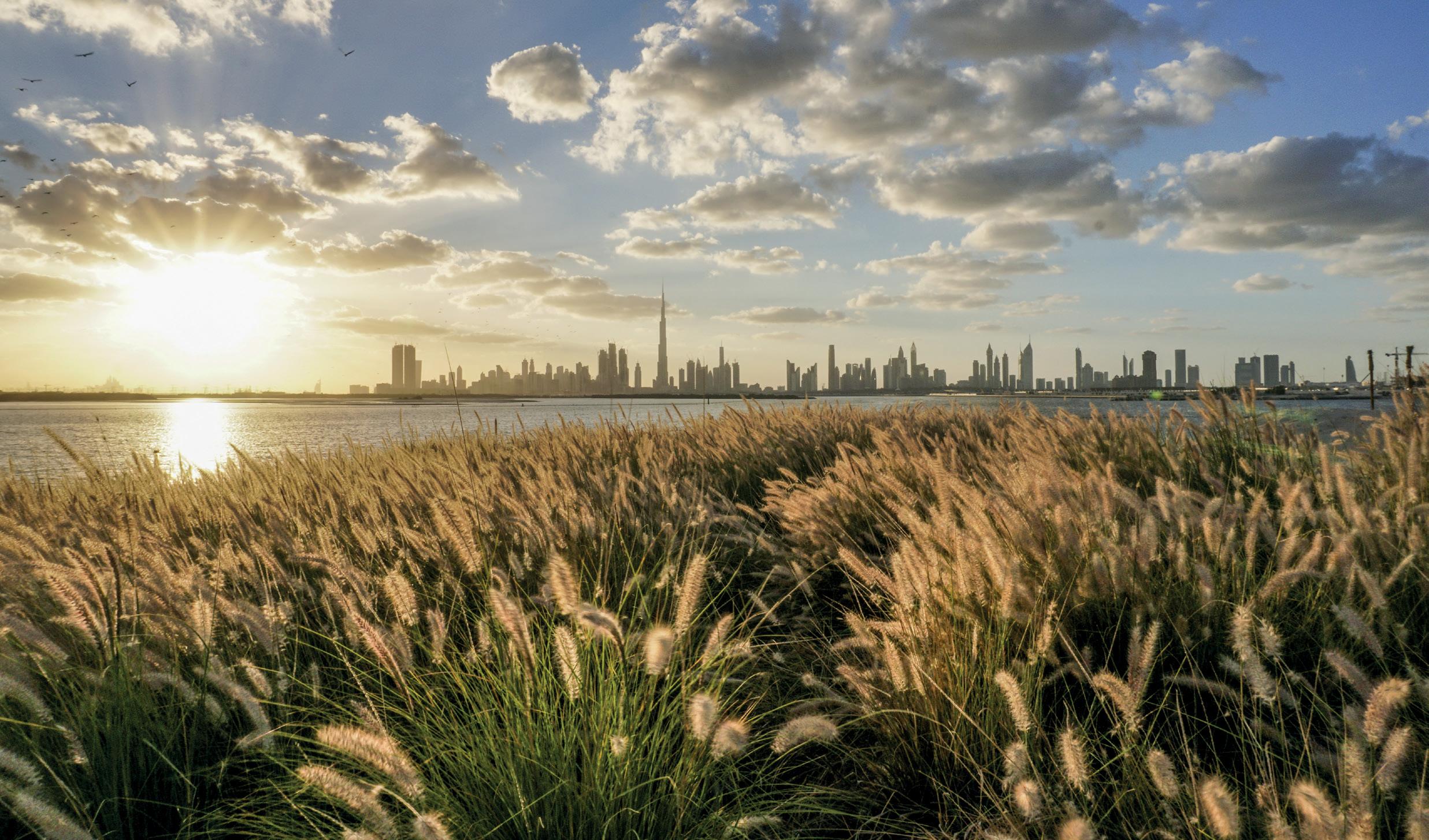
“Key challenges include finding low-carbon alternatives, optimising transportation and logistics from manufacturing facilities to projects, adopting energy efficiency practices during manufacturing and construction, promoting circular economy principles by implementing effective waste management systems, fostering collaboration among the supply chain, and addressing cost disparities for sustainable options,” remarks the team. Here, key built environment stakeholders, including government, developers, consultants and contractors, can play a part in influencing the supply chain to adopt sustainable principles, in support of a Net Zero future.
The team adds, “Clients and contractors can support the supply chain by setting clearer targets, prioritising sustainable procurement, sharing knowledge, evaluating, and selecting the supply chain based on sustainability criteria among technical and financial, and monitoring the supply chain performance. Establishing long-term partnerships can also help a lot.”
“Designers and consultants can drive change by specifying low-carbon systems and materials and focusing
their delivery on sustainable practices in project requirements and specifications. Clients, contractors, consultants, and regulators, all together, can create market demand, foster innovation, and hold the supply chain accountable to its merits. By working in tandem, all of us can pull the supply chain towards contributing to a more sustainable built environment and supporting infrastructure.”
GOVERNMENT INFLUENCE
Countries across the Middle East have launched initiatives that align with the Paris Agreements, and are taking active steps to decarbonise and achieve Net Zero. Several have even unveiled ambitious Net Zero targets including the UAE, which as part of its UAE Net Zero 2050 initiative, aims to be the first country in the MENA region to achieve Net Zero by 2050. Across the world, legislation in support of Net Zero is being rolled out and KEO’s team believes that this is critical to driving tangible change.
“Government legislation can play a key role in driving decarbonisation efforts in both the built environment and infrastructure. But, by government legislation, we don’t mean taxation. Countries such as the USA, UK,
23 IN PROFILE
MEConstructionNews.com | August 2023
55%
KEO have provided strategies which have resulted in projected energy and carbon reduction of up to 55%
Japan, Singapore, and the European Union, have implemented notable measures for moving forward with sustainability and decarbonisation.”
Asked to share their thoughts on what the built environment requires from governments to drive greater Net Zero action, the team responds, “Governments must establish a comprehensive set of policies that include even clearer, and more ambitious, targets for carbon reduction. Such policies may include the development of carbon emissions limits for various industries and the data on the carbon intensity of the power grid on an annual basis. It means also setting continually increasing energy efficiency standards for all industries in predefined times during the next twenty years.”
“There is also a need for local industries to advance on decarbonisation and the government can push forward new technologies, while industrialists can reduce costs due to scalability; another opportunity could be the allocation of funds for R&D in the built environment and infrastructure sectors,” the team explains.
The sustainability team continues, “As taxation may not be the right way forward, streamlining green permitting and regulatory processes is important to increase the number of sustainable projects. Other focus areas that we have seen significant progress on in the UAE during the last months are the improvement of knowledge-sharing, industry collaboration and capacity building.”
Technology could also have a significant impact on the built
environment with regards to its quest to decarbonise and usher in a Net Zero future. BIM has already significantly enhanced the delivery of buildings and infrastructure projects, however new systems and technology could have a pronounced impact with regards to the delivery and long-term operation of assets.
Discussing technology and its potential impact on sustainability, KEO’s experts say, “Artificial intelligence (AI) can help to identify inefficiencies and support to suggest further efficiencies in the design and resource allocation. AI tools that can make ‘more accurate’ energy profile projections, optimise building operations, and assist in supply chain
logistics are near the stage of commercial use. AI can also facilitate life cycle assessments and support more robust decision-making procedures. We need to understand that overall, by leveraging AI tools and technologies, the industry can make more informed decisions, and reduce carbon emissions by adjusting advanced computational modelling capabilities in shorter timespans.”

“As the transition to a Net Zero carbon future will be executed in parallel with AI advancements, we’re sure that there will be significant benefits of using the technology. It is difficult however to see how AI can replace humans on developing and delivering real-estate and infrastructure projects, as AI cannot replace human consciousness and appraisal of aesthetics.”
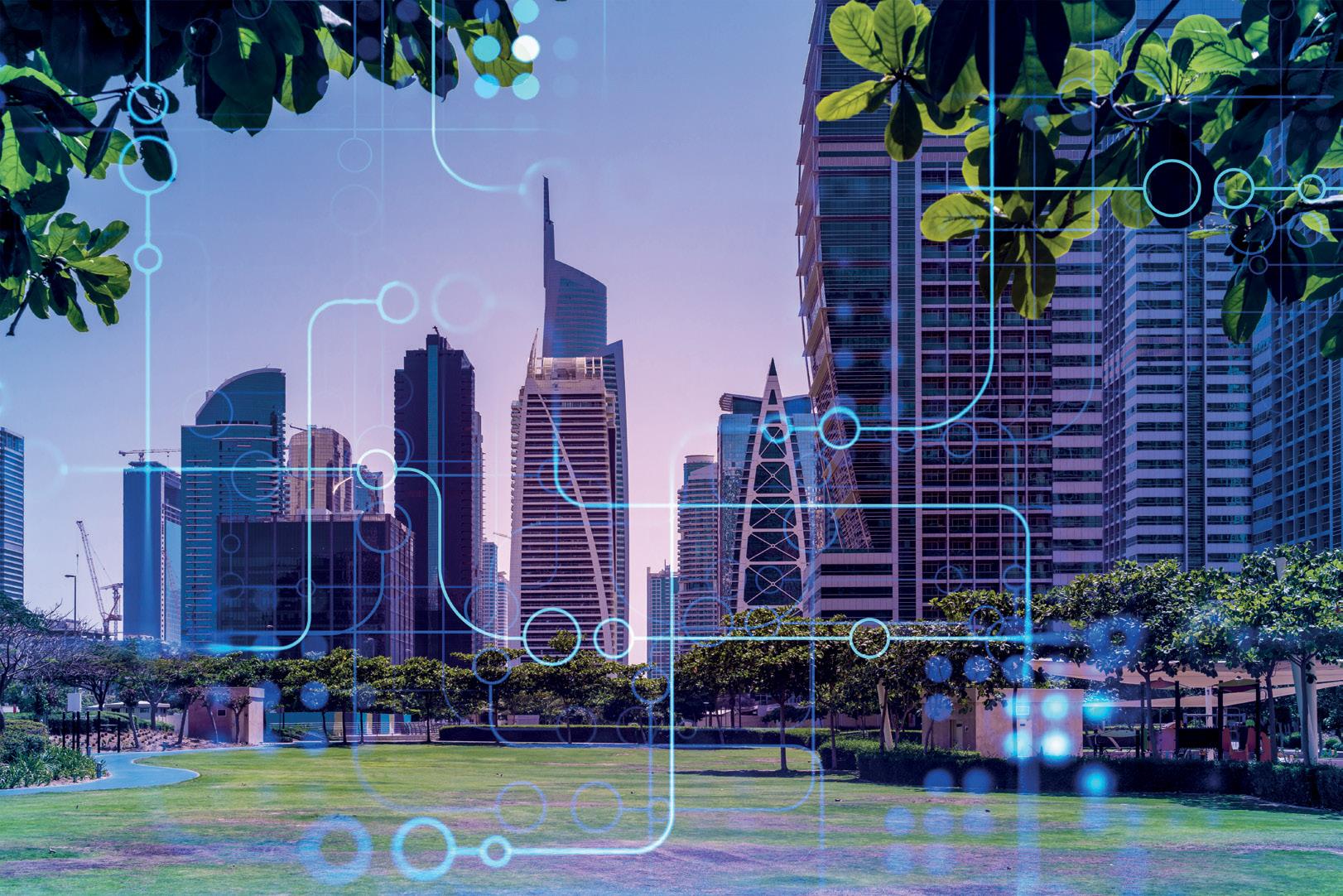
KEO is actively exploring and embracing multiple avenues through which AI can contribute to our work. From design and engineering to project management and sustainability, we recognise the potential of AI to revolutionise various aspects of our operations, they add.
“Reducing GHGe requires a coordinated approach; we all need to cooperate to leverage and scale up any effort for the delivery of a sustainable future,” concludes KEO’s sustainability team.
24 August 2023 | MEConstructionNews.com
IN PROFILE
Artificial Intelligence AI tools that can make more accurate energy profile projections, optimise building operations, and assist in supply chain logistics are near the stage of commercial use.
Technology rising BIM has already significantly enhanced the delivery of projects, however new systems and technology could have a pronounced impact with regards to the delivery and operation of assets.
© 2023 CPI Trade Media. All rights reserved. Content Jason Saundalkar +971 4 375 5475 jason.s@cpitrademedia.com Paul Godfrey +971 55 472 9717 paul.godfrey@cpitrademedia.com Sponsorship Raz Islam +971 50 451 8213 raz.islam@cpitrademedia.com Andy Pitois +971 4 375 5473 andy.pitois@cpitrademedia.com Register now Scan here Riyadh, Saudi Arabia / 17 October 2023 Delivering a Vision – The Knowledge, Engineering, Technology and nuances transforming the Kingdom CONSTRUCTION INTEL SUMMIT KSA SUPPORTING PARTNER PRESENTED BY SUPPORTING PARTNER PRESENTED BY SUPPORTING PARTNER ORGANISED BY SUPPORTING PARTNER SUPPORTING PARTNER SILVER SPONSOR ENDORSED BY constructionintelsummit.com © 2023 CPI Trade Media. All rights reserved. Content Jason Saundalkar +971 4 375 5475 jason.s@cpitrademedia.com Paul Godfrey +971 55 472 9717 paul.godfrey@cpitrademedia.com Sponsorship Raz Islam +971 50 451 8213 raz.islam@cpitrademedia.com Andy Pitois +971 4 375 5473 andy.pitois@cpitrademedia.com Register now Scan here Riyadh, Saudi / Delivering a Vision – The Knowledge, Engineering, Technology and nuances transforming Kingdom CONSTRUCTION INTEL SUMMIT KSA SUPPORTING PARTNER SUPPORTING PARTNER SILVER SPONSOR SUPPORTING PARTNER SUPPORTING PARTNER SUPPORTING PARTNER ORGANISED BY PRESENTED BY SUPPORTING PARTNER SUPPORTING PARTNER PRESENTED BY ENDORSED BY SUPPORTING PARTNER constructionintelsummit.com

26 August 2023 | MEConstructionNews.com
Showcasing Excellence
JASON SAUNDALKAR TALKS
TO AESG ’S CHIEF TECHNICAL OFFICER, ADAM MUGGLETON, ABOUT THE INSPIRATION BEHIND HIS NEW BOOK, THE NEED FOR INSPIRATIONAL FIGURES IN THE ENGINEERING SPACE, TAKING SUSTAINABILITY A STEP FORWARD IN THE BUILT ENVIRONMENT, AND HOW TECHNOLOGY CAN BE A SIGNIFICANT ENABLER OF A SUSTAINABLE FUTURE


27 MEConstructionNews.com | August 2023
IN
AESG
PROFILE
s a whole, the built environment has several pressing issues to address, but perhaps the most crucial are: reducing the negative impact of construction and operations on the environment to prevent catastrophic climate change, and better highlighting engineering discipline experts, so they can serve as inspirational figures that attract fresh talent to the sector.

Both issues have been highlighted and talked about significantly in the industry, and while some progress has been made, there’s still a long road ahead before both challenges can be put to bed. These are issues that Adam Muggleton is acutely familiar with, and has been attempting to address via a number of different avenues, including speaking engagements and podcasts.
Muggleton is a construction industry veteran with decades of global experience and is now Chief Technical Officer at AESG. Through his new book ‘Wisdom of the Property Crowd’, Muggleton aims to shine a spotlight on both critical issues and provoke positive change.
Discussing the inspiration behind the book in greater detail, Muggleton says, “There’s a couple of real reasons for it: the first is, I’ve got a daughter who is a Mechanical Engineer who went through four years of university and, at the end of it, she and her friends didn’t really want to work in the built environment. My question was ‘why?’ and their answer was that there were no real role models. They all wanted to work for Elon Musk and do exciting things like work on the space program and get people to Mars. Their point to me was ‘where are the Elon Musks in the built environment?’ That got me thinking.”
“I have a podcast called the Edifice Complex, which I host with a colleague called Robert Bean. We try and interview the hidden heroes, the hidden

innovators, the hidden masters of their craft, and bring them out, so that they’re available for people like my daughter and her friends to model themselves on. So what I’m really trying to do is bring great work out, highlight great people, and then put them out there as role models.”
Muggleton states the book took two years to put together, which involved identifying the right people to feature from his bank of content, interviewing them, along with editing and going from the first draft to the final. The book features 10 different individuals that represent a diverse range of individuals and expertise such as ethics, biodiversity, biophilia, sustainability and engineering, he points out.
He’s pleased with the book and notes he’s been receiving positive feedback, “It’s been well received so far and features some truly awesome people. Our industry is fantastic in many ways because our work is visible but the people behind that work are sometimes invisible. They’re not well known but they should be!”
Certifications
Muggleton reckons existing certifications are going to give way to more evidence based and performancebased certifications, as the technology to inexpensively track performance becomes more available.
PERFORMANCE DRIVEN CERTIFICATION
Shifting gears to sustainability in the built environment, there is a growing focus on decarbonisation and achieving sustainable certifications on building performance. A number of these certifications can be sourced by ensuring a building has the necessary sustainable requisites, however, at Big Project ME’s second annual edition of the Energy & Sustainability Summit, several panellists noted that it’s important for the industry to transition to evidence/performancebased sustainability certifications.
Asked about his thoughts on this issue, Muggleton says, “There’s a lot of change going on quietly behind the scenes right now - I think we are moving from a world where existing certifications are going to give way to more evidence based and performancebased certifications. It’s becoming inexpensive and easy to measure performance using technology, and that’s going to raise issues and awareness.”
“There is also an aspect of accountability coming into the mix. At AESG, we’ve got a range of generations from Gen Z all the way up to baby boomers - I’m very enthusiastic about working with young people because they hold us accountable. They call us out and they’ll ask “How is it sustainable?” Here, you can’t just point out that certificate on the wall anymore, you’ve got to come up with some facts and figures. That’s the world we’re moving into.”
Asked about how long it might be before the industry makes the shift, Muggleton responds, “It’s probably three to five years; NABERS, the Australian performance-based certification system is gaining more prominence in the Middle East and the UK, and that’s starting the ball rolling. At the moment we’re still in the early adoption stage, whereas in three to five years, I think it’d be more of a common occurrence.”
Muggleton also points out that existing commissioning codes are being upgraded in step with what’s going on in the industry to maintain their relevance. “With organisations such as the Chartered Institute of Building Service Engineers (CIBSE) in the UK, they are upgrading all their commissioning codes right now to
28 August 2023 | MEConstructionNews.com
IN PROFILE
600 Currently there are over 600 green building certifications across the globe
be more relevant, and to represent what’s going on in the built environment.”
“There’s also a nod to the accountability that’s going to come from the visibility given by technology. So yes, CIBSE has started with Commissioning Code M, which is commissioning management, and I’m currently working on Commissioning Code A, which is air systems. There’s a recognition that things need to be updated. ASHRAE are also currently working on the update of the ongoing commissioning code; they are reorganising all their commissioning codes to recognise this new world we’re moving into, where it’s not just a nod and a wink anymore, you’ve got to tackle sustainability properly. Both of these organisations are recognising this change, or they wouldn’t be updating their codes otherwise.”
Speaking about the different organisations and whether there are certain aspects of sustainability that they are coming together around in unison or if each operates independently, in silos, Muggleton comments that cultural national silos are an issue.

That said, he remarks, “What’s overarching on all of that is ESG, climate awareness and climate emergency awareness. Due to this, people are getting their house in order and I
actually think these silos will dissolve over time, and it will all meld into one. But at the moment, yes, it is silo based, and that is driven by national culture, and national and local building codes.”
Muggleton states that, through his research, he’s found that there are over 600 green building certifications across the globe but both he, and AESG CEO Saeed Al Abbar believe that change is coming in locally from a municipal level.
“A lot of municipalities around the world are starting to adopt green building standards and sustainability standards into building code. And that provokes changes at the root level and that’s significant. It’s really going to change things.”
As an industry veteran who’s held several senior positions in organisations across the globe, Muggleton has been able to watch and experience the built environment from several different angles. Pressed about one issue he’d like to see the industry embrace as a whole, he loops back to his earlier sentiment about celebrating people in the sector, and notes it is important to celebrate engineers and the engineering and sustainable problems they can solve.
“At present, society doesn’t quite value engineering expertise. Architects have gained prominence over the years and are
seen as the rockstars of our business, but I think we’ve got to move to a stage where the engineers and the scientists have an acknowledgement as well. We need to celebrate them because, going back to my daughters and her friends, there’s no rockstar glamour attached to being an engineer. I would love to see us as a society - and as an industry - celebrate engineering, and make the real leaders in the field bit more like rockstars. Everyone knows who Sir Norman Foster is but who is the Norman Foster of engineering?”
GREAT DESIGN, WRONG LOCATION?
Discussing sustainable structures and whether designs will begin to change in warmer climates such as the Middle East, as developers look to boost their assets’ energy efficiency, Muggleton says that he’s come to realise that architecture and design is tied to culture.
“As I’ve got older, I’ve realised that architecture and buildings are as much a function of culture, as they are engineering and use case. In the Middle East, we’ve adopted a culture of the glass tower; how practical that is in the long run is up for debate. One way to look at architects is as influencers - they are the connection between the client, the users and the engineers, and I think architects have a duty of care to be
29 MEConstructionNews.com | August 2023 IN PROFILE
Inspirational figures Through his book, Muggleton hopes to highlight and celebrate individuals in the built environment and position them as role models to attract fresh talent.
10 Muggleon’s book took two years to produce and features 10 different individuals across a number of disciplines
I would love to see us as a society - and as an industry - celebrate engineering and make the real leaders in the field bit more like rockstars. Everyone knows who Sir Norman Foster is but who is the Norman Foster of engineering?”
influencers to owners, and help them drive the design solution more towards a sustainable one. That said, it also seems to go back to ‘what do you have to do’ rather than ‘what should you do?’ That’s where municipalities can come in and drive change because, particularly, in the contracting environment, you wind up with ‘I’m doing what I have to do because that’s what we’re being paid for’. So, we must get best practice into the contract and that has to come from the municipality level.”
The Middle East has an appetite for megastructures and megaprojects, and this has been a trend that has persisted for several years. Pressed for his thoughts on whether megaprojects can be delivered and operated sustainably, Muggleton says it is indeed possible.
“I believe you can embed sustainability into everything, but you must do it intentionally from the start. It has to be a directive from the owner and from the architects originally, and you can do things like high-performance glazing, and you can embed sustainable features and high efficiency equipment and systems into buildings.”
He continues, “It’s difficult to do when you are working from a first cost basis. This is why you need the architects and the owners to be champions of sustainability and push that thinking through. There are some amazing technologies out there, and there are proven design solutions for sustainability, and you have to intentionally adopt them. If you’re going into a low cost, minimum compliance bin, it’s very hard to put that in at that point.”
Achieving sustainable results on construction projects is associated with upfront costs, however a sustainable approach could ultimately mean cost savings in the long-run. Muggleton once again points to technology as being essential to provoking change.
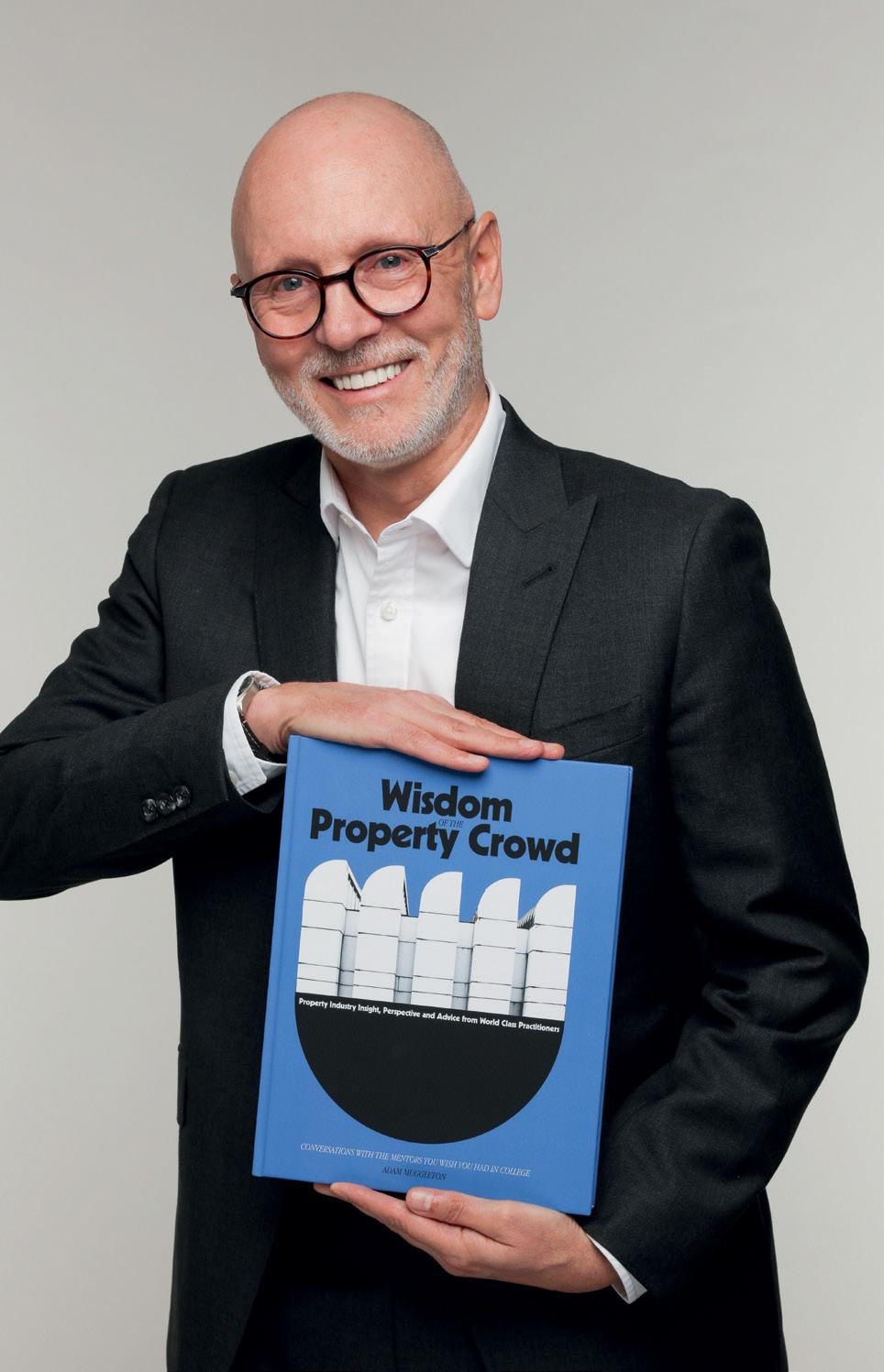
“Greater visibility of building performance is going to break that cycle. I’m really enthusiastic about the world moving into IoT monitoring in real time because that’s going to bring the visibility to the owners of buildings. At the moment, you need to be quite technical and be well versed in a certain discipline to understand what’s going
on. But, we’re moving into a world now of digital dashboards and real time performance monitoring - that dashboard can be tuned to communicate at the board or owner level.”
“That will then bring the visibility, and then the questions will come down from the top: why is it like this?; why is it not as good as this? etc. The fact that visibility of performance in real time is coming down the pipe fast is what makes me optimistic. It’s going to prompt people to ask awkard questions, and that will make everyone from the design team to the contractor to raise their game.”
One of the issues holding the built environment back from adopting a long-term sustainable view on projects rather than cost first, has to do with the developers’ business model.
“There are two types of developer. There are those that build to sell and they’re all about cost first, and that’s the hardest problem to solve. I think the only way you solve that problem is through legislation. But, there are also developers who build to own and run directly. The obvious example is university campuses – those are built to be used for decades, and that’s where there is an interest in total cost of ownership, rather than first cost. In those particular cases, you can have great conversations about sustainable elements
and plan for the long-term return.”
Muggleton points out here that AESG is working on several significant projects in Saudi Arabia and notes, with the gigaprojects, that sustainability is adopted as a design principle from the get-go.
THE RIGHT MOMENT?
COP28 will be held in the UAE between 30 November and 12 December 2023. It is expected to take stock of current progress on achieving The Paris Agreement, which was signed at COP21 in 2015.
Pressed for his thoughts on what the event might bring and whether it could provoke significant sustainable movement, Muggleton says, “The Middle East is having a moment – we’ve just had the FIFA World Cup Qatar 2022 and EXPO 2020 Dubai, and there’s several gigaprojects underway. There’s a lot going on, and I like the fact that the event is taking place in the UAE because it brings a spotlight on the region and on sustainability. So, even if there’s no hard promises coming out of it, it will still move the needle.”
He continues, “The days of vague promises are over. COP is a good example of evolution as we’ve gone from vagueness to being specific. With all that’s happened in the region and what’s going on now and with COP28 taking place here, I think it will bring a need to raise the game and do things better, and to a higher standard.”
Making his closing statement, Muggleton notes that as he gets closer to the end of his career, he is focused on making the built environment more attractive to people across the globe.
He emphasises, “When I wrote this book, it was to try and put these examples out there; we’ve got to encourage and champion people into STEM subjects, and get them to join the industry and that comes by being enthusiastic and celebrating exceptional work.”
“There’s a guy called Peter Simmonds who’s accomplished and written the ‘ASHRAE Design Guide for Tall, Supertall and Megatall Building Systems’. He’s probably one of the top 10 engineers in the world - every engineering student should know his name, but no one does. He’s the Norman Foster we need to hear about!,” concludes Muggleton.
30 August 2023 | MEConstructionNews.com IN PROFILE
2 Muggleton states that the book took about two years to put together, starting with selecting the right people from his bank of podcast content
The author Adam Muggleton is Chief Technical Officer at AESG.

Complimentary Register for free and fowsummit.com
MIDDLE EAST
A Pathway to Sustainability
The built environment contributes significantly to global carbon emissions, making it crucial to take steps towards reducing its carbon footprint. In this article, we will examine the importance of decarbonising buildings in the GCC, and the required collaborative efforts by the public and private sectors to achieve national Net Zero ambitions. Green building practices, renewable energy sources, and energyefficient technologies play a role in meeting the 1.5-degree target – limiting the global average temperature increase to 1.5°C above pre-industrial levels.
However, the path to Net Zero buildings requires integrated planning for low-carbon communities, and the adoption of a comprehensive building decarbonisation methodology, underpinned by data-driven solutions developed to decarbonise existing building portfolios in an effective way. As the UAE will host the 28th Conference of the Parties to the UN Framework Convention on Climate Change (COP28), there is a great opportunity to drive collaboration and action plans towards mitigating climate change risks and decarbonising the built environment across the region.

August 2023 | MEConstructionNews.com 32
A clear strategy highlighting the advantages of owning and operating low-carbon buildings can drive positive changes aligned with national Net Zero targets write Atkins’ Mayuko Totsuka and Dr. Mohsenah Al Yami
COMMENT Atkins
NATIONAL TARGETS IN THE GCC
Countries in the GCC region are taking significant initiatives to reduce their carbon footprint in the built environment by setting targets for renewable energy generation and implementing energy efficiency programs. The United Arab Emirates (UAE) has committed to generating 50% of its energy from clean sources by 2050, while the Kingdom of Saudi Arabia (KSA) has set a target to generate 50% of its electricity from renewable sources by 2030.
Qatar aims to generate 20% of its electricity from renewable energy

sources by 2030. Oman has also set a goal of generating 30% of its energy from renewable sources by 2030. In Bahrain, the government has launched a program to retrofit buildings with energy-efficient technologies. In 2020, Saudi Arabia launched the concept of the circular carbon economy at the G20 summit to align fossil fuel producers’ interests with Net Zero emissions trajectories.
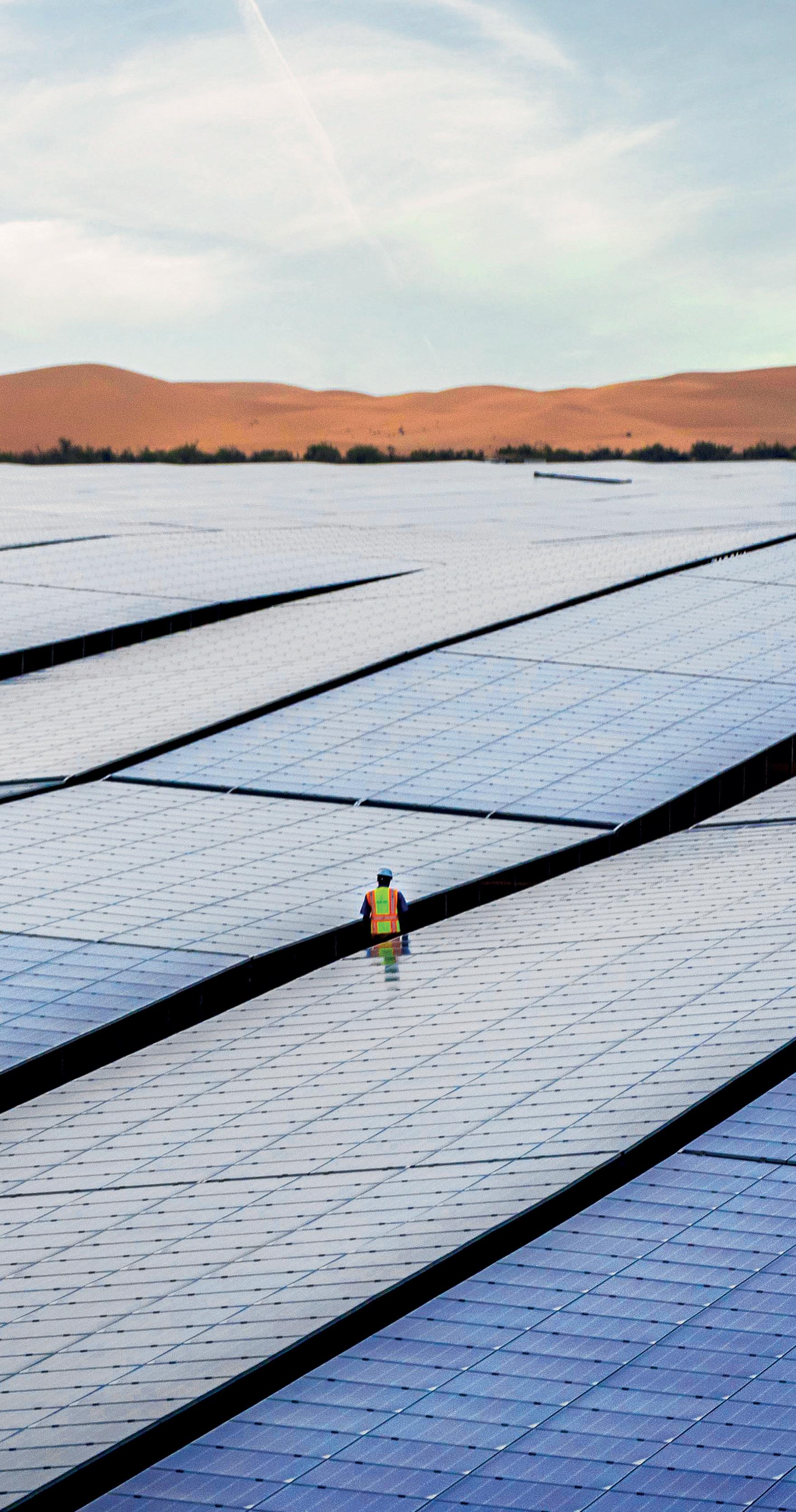
MASTER PLANNING OF LOW-CARBON COMMUNITIES
The GCC region has an advantage in greenfield planning for creating sustainable and low-carbon communities. However, there has been a tendency in the region to prioritise gated communities and car-dependent lifestyles.
According to the SNC-Lavalin Group’s report on ‘Engineering Net Zero in the GCC’, a people-centric approach is necessary, considering access to community amenities and alternative modes of transportation. As the report emphasises, holistic city planning and design are required to address carbon emissions in the built environment, energy, and transport sectors.
Saudi Arabia is currently delivering megaprojects along the Red Sea coast to develop cities powered by 100% renewable energy, including solar, wind, and green hydrogen. The cities are envisioned to be Net Zero carbon by prioritising people’s health and well-being over carbon-intensive transportation and infrastructure.
The UAE’s Dubai 2040 Urban Master Plan focuses on sustainable development, reducing energy demands, and promoting sustainable mobility. The plan also promotes integrated communities with green spaces and recreational facilities.
BUILDING DECARBONISATION
The Intergovernmental Panel on Climate Change (IPCC) highlights that greenhouse gas emissions need to decline 43% by 2030 relative to 2019 levels to limit global warming to 1.5°C. Buildings make up almost 40% of global carbon emissions with 28% coming from existing stock. Therefore, a comprehensive building decarbonisation
methodology needs to be implemented to achieve the 1.5-degree target.
The methodology focuses on establishing a baseline of current emissions to set decarbonisation ambitions and targets and develop a tailored strategy. By following this approach, an organisation can measure and report progress on the plan and make any required adjustments to meet its building decarbonisation targets.
To help reduce carbon emissions for existing buildings, SNC-Lavalin launched ‘Decarbonomics’, an innovative datadriven solution designed to decarbonise existing assets in a cost-effective manner. Recognising that buildings contribute significantly to global carbon emissions, with a large portion attributed to existing structures, Decarbonomics focuses on making carbon visible and maximising the value of assets, while reducing carbon footprint. It generates robust and intuitive portfolio and asset-level views of the organisation’s decarbonisation journey and the associated cost across the entire estate regardless of condition or global distribution.
The decarbonisation approach begins by capturing, structuring, and managing portfolio data, including benchmarking current performance, and addressing any data gaps. Leveraging industry-leading carbon data insights, Decarbonomics analyses carbon, cost, and engineering solutions to develop customised roadmaps for cost-effective implementation. Artificial intelligence and machine learning are utilised for scenario testing and generating optimal decarbonisation strategies.
CHALLENGES AND SOLUTIONS
Despite progress, challenges remain, including the high initial costs of implementing green technologies and the need for greater education and awareness of sustainable building practices. Hence, addressing challenges to the decarbonisation of the built environment in the GCC requires several considerations.
First, it is crucial to implement policy and legislation for strategic land use planning that prioritises sustainability. This entails revitalising existing sites in metropolitan areas rather than extensive
33 MEConstructionNews.com | August 2023
COMMENT
50%
The UAE hopes to generate 50% of its energy from clean sources by 2050
new construction. Additionally, stricter rules should be enforced for regenerating and retrofitting existing buildings to enhance energy efficiency, internal comfort, and overall wellbeing. The Emirates Green Building Council has launched initiatives to promote sustainable building practices in the UAE, including retrofit programs for energy-efficient technologies.
Second, it is important to establish incentives and drivers for these initiatives to accelerate their implementation. Shifting thinking around energy use is vital for achieving sustainability goals. Demand-side management, which involves actively managing and optimising energy consumption, also play a role in energy planning. Governments can promote effective facility management planning from the design stage of major assets. This approach ensures that investments perform optimally, with controlled maintenance costs, and attract higher-value tenants.
Third, building decarbonisation requires not only looking at the capital cost involved, but also evaluating the whole life-cycle cost of the building from materials to systems, specifications and operations and maintenance. The developers and operators of the building portfolio can benefit from creating an intelligent cost and program optimised decarbonisation
Sustainability experts
roadmap that integrates existing life-cycle replacement with asset management data.

Collaboration between all stakeholders is key to achieving the goal of decarbonising the building sector in the GCC. Integrating land use and urban transport planning into community and building design is necessary to reduce energy needs and achieve Net Zero goals. The efforts should be accelerated for retrofitting existing buildings with energy-efficient technologies, promoting renewable energy systems, and enforcing green building codes and regulations.
THE WAY FORWARD
Achieving the ambitious 1.5-degree target and mitigating the severe impacts of climate change require bold actions from all sectors, including the building and construction industries. These industries can contribute by adopting sustainable building practices and transitioning to renewable energy sources, aiming to reduce carbon emissions by 50% by 2030 and achieve zero net emissions by 2050, in line with the IPCC proposition. Global initiatives such as the European Union’s ‘Renovation Wave’ and the US Department of Energy’s ‘Better Buildings Initiative’ provide valuable lessons and emphasise the importance of energy efficiency and decarbonisation in buildings.
Delivering high-performing built environment solutions is a crucial step towards decarbonising cities in the GCC. To bring about significant change across the built environment lifecycle, it is essential to adopt comprehensive decarbonisation methodologies, address policy, enhance legislation, and review codes.

A well-communicated and clear strategy highlighting the advantages of owning and operating low-carbon, highly efficient buildings can drive positive changes aligned with the national Net Zero targets. By prioritising these measures, the region can effectively transition towards a sustainable and resilient built environment.
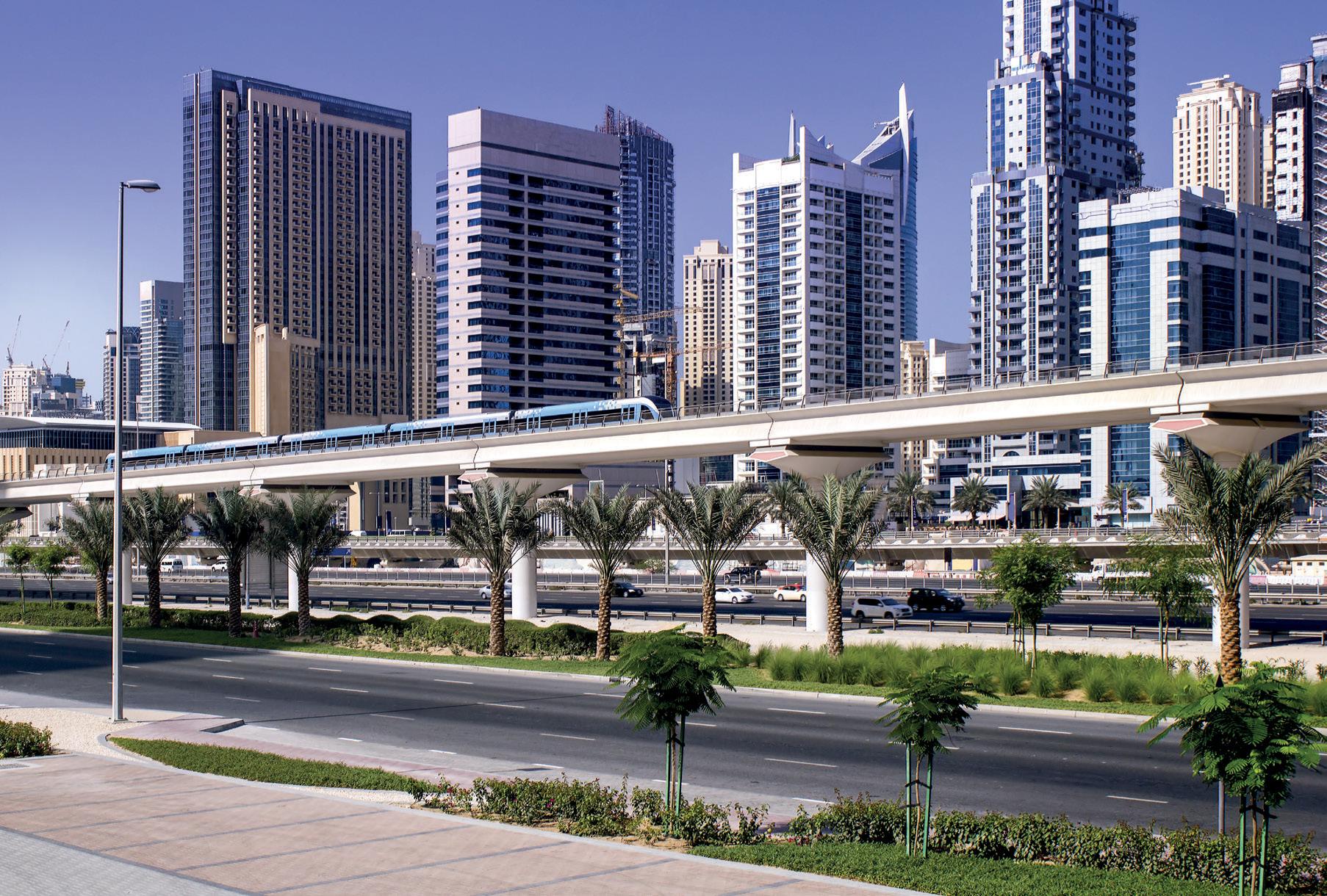
34 August 2023 | MEConstructionNews.com
Mayuko Totsuka, Sustainability Lead, Strategic Advisory, Middle East (left) & Dr. Mohsenah Al Yami, Sustainability Advisor, Strategic Advisory, Middle East Atkins, a member of the SNC-Lavalin Group.
COMMENT
A sustainable master plan The Dubai 2040 Urban Master Plan focuses on sustainable development, reducing energy demands, and promoting sustainable mobility.
© 2023 CPI Trade Media. All rights reserved. Content Jason Saundalkar +971 4 375 5475 jason.s@cpitrademedia.com Sponsorship Madeleine Martin +971 58 536 1208 madeleine.martin@cpitrademedia.com Sponsorship Raz Islam +971 50 451 8213 raz.islam@cpitrademedia.com Complimentary Register Now Register for free and stay connected Tuesday 26th September 2023 HABTOOR GRAND RESORT / DUBAI / UAE Cutting-edge technology is transforming the delivery and sustainable operation of regional megaprojects PRESENTED BY PRESENTED BY PRESENTED BY BRONZE SPONSOR GOLD SPONSOR BRONZE SPONSOR GOLD SPONSOR SUPPORTING PARTNER ENDORSED BY digitalconstructionsummit.com
Fakhruddin Properties
How technology can help address the challenges of ESG management
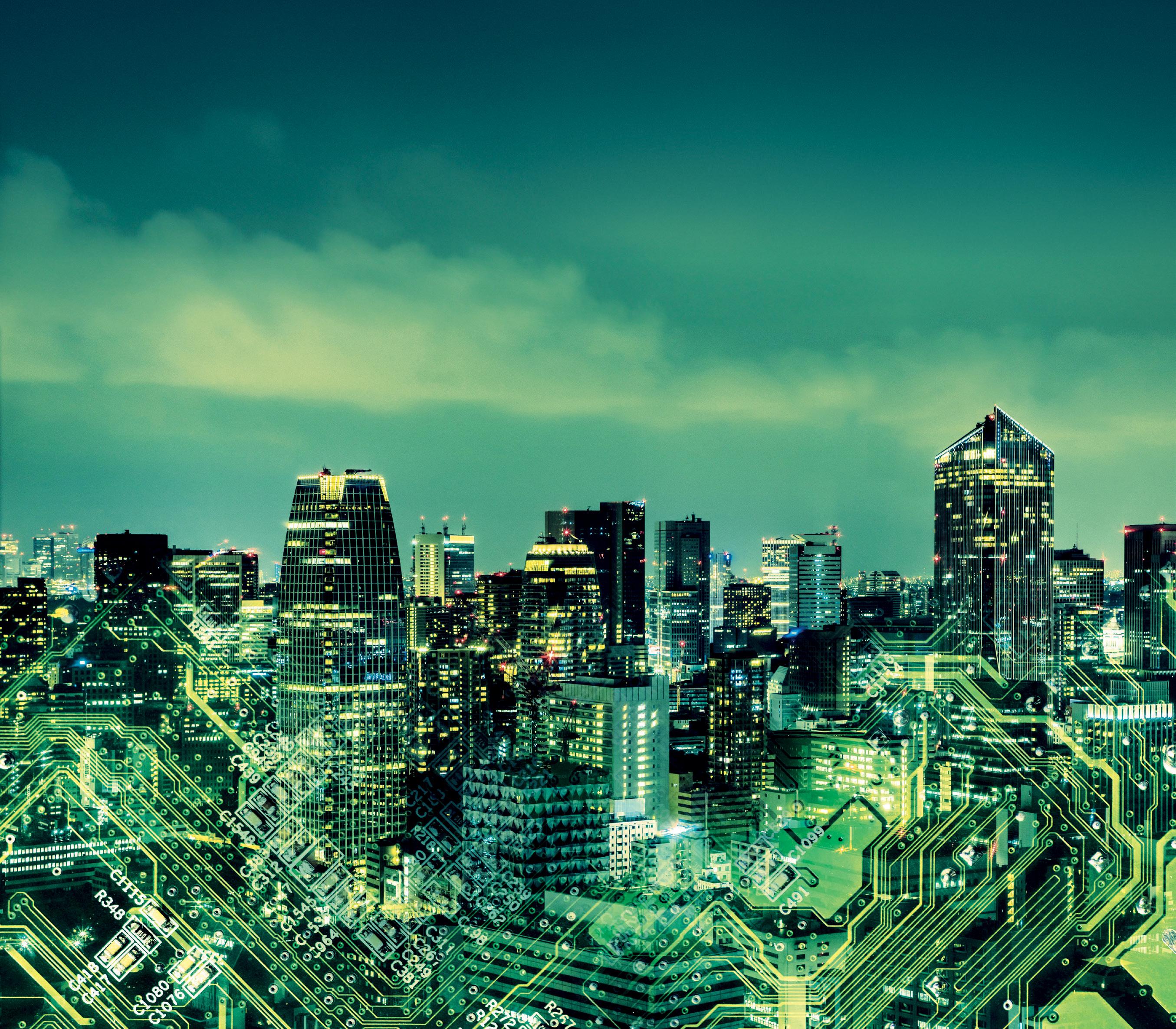
In the evolving global landscape, Environmental, Social, and Governance (ESG) factors have ascended to the forefront of the real estate development industry. As stakeholders increasingly prioritise sustainability, developers face the intricate challenge of effectively and practically managing ESG factors. These factors demand heightened transparency, operational efficiency, and robust stakeholder engagement.
The environmental component of ESG encapsulates a company’s impact on the world. It necessitates the efficient management of resources, reduction
of carbon emissions, minimisation of waste production, and preservation of natural habitats. In this context, data analytics emerges as a critical tool, offering detailed insights into a building’s environmental footprint, and facilitating informed decision-making.
Advanced analytics tools, equipped to process vast volumes of data, can identify intricate patterns and trends that would otherwise remain obscured. For instance, by analysing energy consumption data, developers can identify operational inefficiencies and implement appropriate measures to rectify them.
August 2023 | MEConstructionNews.com 36
Embracing technology and innovative solutions can enable the real estate sector to tackle the challenges of ESG management writes Yousuf Fakhruddin, CEO of Fakhruddin Properties
MIDDLE EAST
COMMENT
Similarly, waste generation data can guide the formulation of effective waste management strategies, promoting the principles of a circular economy.
Moreover, water usage data can inform water conservation efforts, contributing to the sustainable use of this precious resource. By harnessing the power of data analytics, developers can enhance their environmental performance, demonstrating a tangible commitment to environmental stewardship and aligning their operations with global sustainability goals.
SOCIAL RESPONSIBILITY
The ‘social’ aspect of ESG encompasses a company’s relationships with its technical and operational staff, customers, suppliers, and the wider community. In residential buildings, IoT devices can enhance living conditions by optimising energy use, improving indoor air quality, and enabling smart home features. Furthermore, IoT technology can aid developers in understanding and responding to the needs of local communities.
For instance, smart meters can provide insights into energy consumption patterns, informing the development of energy-efficient housing solutions that not only reduce carbon emissions but also lower utility costs for residents. By leveraging IoT technology, developers can enhance their social responsibility, contributing positively to society and fostering goodwill among stakeholders.
DRIVING EFFECTIVE GOVERNANCE AND RISK MANAGEMENT
Governance pertains to the leadership structure, transparency, accountability, and ethical conduct of an organisation. In real estate development, effective governance can facilitate the successful execution of projects that promotes the 3Ps of Sustainability - People, Profits and Planet.
It is essential to also acknowledge the importance of the fourth ‘P’‘Practical’ - within the context of real estate. BIM offers significant potential in enhancing governance practices. It enables developers to create detailed 3D models of buildings, providing a

comprehensive overview of a project before construction begins. This allows stakeholders to visualise the project’s potential impact on the environment and the community, promoting transparency and accountability. Moreover, BIM can facilitate risk management by helping developers anticipate and mitigate potential issues during the design, development, operational and handover phase. This can lead to fewer errors, minimised waste, and optimised resource utilisation during construction, thereby fostering sustainable construction practices and creating vibrant and efficient communities. By leveraging BIM, developers can ensure their governance structures and processes align with their ESG goals, enhancing stakeholder trust and confidence in their operations.
REVOLUTIONISING ENGAGEMENT
In the era of digital transformation, stakeholder engagement has evolved to more interactive and inclusive digital platforms. These platforms offer avenues for transparent and timely communication. Developers can leverage these platforms to disseminate information about their ESG initiatives, gather feedback, and build relationships with stakeholders. For instance, developers could host virtual town hall meetings to discuss proposed projects, encouraging community participation
and fostering a sense of ownership among stakeholders. By fostering open dialogue and collaboration, developers can enhance their reputation, gain valuable insights, and drive meaningful change in their ESG practices.
STREAMLINING ESG REPORTING
ESG reporting, while crucial, can often be a complex and time-consuming process. Smart building management systems (BMS) can simplify this process by continuously monitoring a range of sustainability indicators. BMS can generate reports on energy consumption, greenhouse gas emissions, waste generation, and other key metrics. This not only saves time but also improves the accuracy and reliability of the reports.
By adopting smart BMS, developers can streamline reporting processes, enhancing transparency and demonstrating their commitment to sustainability. In Fakhruddin Properties’ upcoming development, Maimoon Gardens, for instance we’ve incorporated a full-fledged BMS, which will be integrated with an app. Residents will have control over various aspects of their living environment at their fingertips.

In addition, we provide residents with rewards as a token of appreciation for their active participation in our sustainable initiatives.
At our organisation, we embrace the power of technology and innovative solutions to tackle the challenges of ESG management. By leveraging data analytics, artificial intelligence and other technologies, we incorporate sustainable practices and foster responsible development. We strive to enhance environmental stewardship by analysing and optimising resource usage, while also promoting social responsibility through improved living conditions and community engagement.
Our commitment to effective governance ensures transparency, accountability, and risk management, leading to efficient construction practices. By adopting these initiatives, we strive to create a better future, where sustainable practices and vibrant communities coexist harmoniously, while making a positive impact on this planet.
37 MEConstructionNews.com | August 2023
COMMENT
Tools of the ESG trade Advanced analytics tools, equipped to process vast volumes of field data, can identify patterns and trends that would otherwise remain obscured.
Technology and ESG advocate Yousuf Fakhruddin is the CEO of Fakhruddin Properties.
Blending the Wisdom of the Past with Modern Innovations
Ceramic Tiles
In a world grappling with the pressing need for sustainable solutions, the United Arab Emirates (UAE) stands at the forefront of change. With the construction and architecture sector responsible for a staggering 40% of global emissions, the UAE’s commitment to embracing sustainability and combating global warming has never been more crucial.
The revival of ancient Arab architecture holds the key to this ecoconscious future, seamlessly integrating ceramic tiles with bioclimatic design and production principles while preserving the region’s rich cultural heritage.
UNEARTHING SUSTAINABLE HERITAGE
Remnants of sustainable practices from ancient Arab architecture can still be found in the UAE’s architectural landscape. Windcatchers and mashrabiya screens, ingeniously designed by the ancients, are examples of their wisdom.
Windcatchers harnessed cool winds from above and channeled
them into living spaces, providing effective air cooling without energyintensive systems. Mashrabiya screens meanwhile dispersed sunlight, while allowing fresh air circulation, creating natural and efficient cooling effects. Combined with fossilised coral and the ‘badkesh’ ventilation system, these features offer a blueprint for sustainable living in the desert.
The utilisation of windcatchers and mashrabiya screens in modern architecture represents a revival of these ancient techniques. Architects and designers in the UAE are incorporating these elements into their projects, ensuring that the wisdom of the past is not lost but rather integrated into the contemporary built environment. By blending traditional principles with modern technology, the UAE is forging a path towards sustainable living in a region known for its extreme climate.
REVITALISING CENTURIES-OLD
PRINCIPLES WITH CERAMIC TILES
Spanish ceramic tiles bring a wealth

August 2023 | MEConstructionNews.com 38
EAST COMMENT
ASCER -Tile of Spain’s Clara Vicedo says a marriage of sustainability and cultural heritage can ensure a more resilient and sustainable built environment for generations
MIDDLE
of benefits to sustainable design, making them an indispensable component of modern architectural marvels. With exceptional insulation properties against water and external temperatures, these tiles enhance the efficiency of buildings with vented façades or ‘badkesh’ ventilation. They can help regulate temperature and reduce energy consumption by acting as a barrier to the external environment.
Furthermore, covering floors and walls with ceramic tiles not only provides a personalised design but also helps to reduce the reliance on extensive heating and air conditioning, contributing to substantial energy savings. The thermal properties of these tiles enable them to retain heat in cooler months and maintain a cool environment during hotter periods; this not only reduces the need for artificial heating and cooling but also minimises energy consumption and associated greenhouse gas emissions (GHGe).
Incorporating ceramic tiles in buildings or residences can result in annual energy savings of 20-30% in commercial settings. This significant reduction in energy consumption not only lowers carbon emissions but also contributes to cost savings for building owners and occupants. The sustainability benefits of using ceramic tiles extends beyond energy efficiency; these tiles are durable, long-lasting, and require minimal maintenance, leading to a reduced environmental footprint over their lifecycle.
A SUSTAINABLE COMMITMENT
The Spanish ceramic industry is revolutionising sustainability. Committed to a circular economy, Spanish ceramics have implemented a zero-discharge water treatment system, saving a staggering 1,200,000 tons of wastewater per year. This commitment to efficient water management not only conserves a precious resource but also

mitigates the potential environmental impact of wastewater discharge.
These tiles are manufactured using environmentally friendly production processes and materials - they are free from harmful chemicals and allergens, and promote a healthier and greener environment for building occupants. Stringent quality control measures ensure that these tiles meet the highest standards of sustainability, making them an ideal choice for ecoconscious construction projects.
REVIVING THE SPIRIT OF ANCIENT ARAB ARCHITECTURE
The UAE proudly showcases the revival of traditional Arab architecture through various ambitious projects.
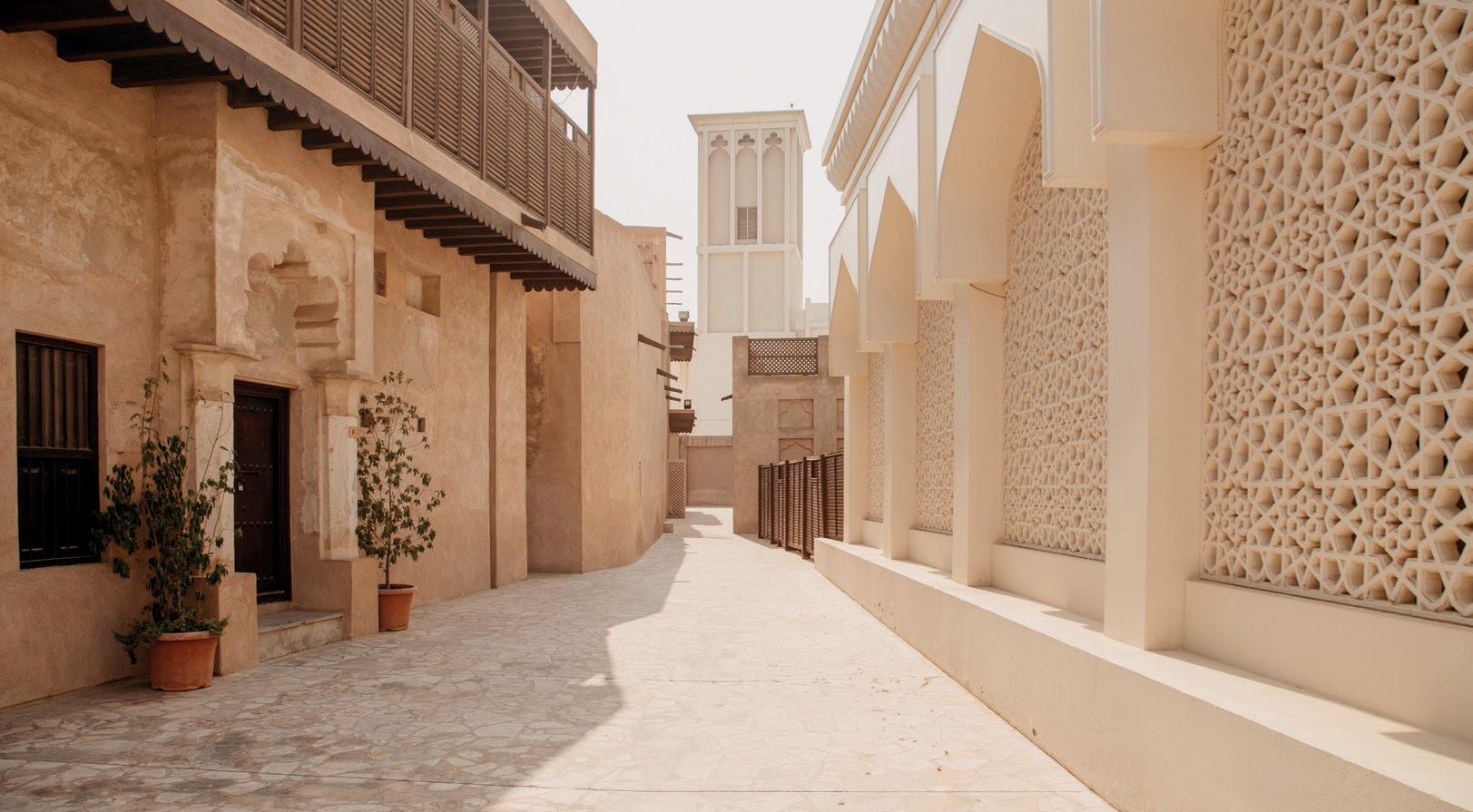
Dubai’s Al Fahidi Historical District, a UNESCO World Heritage Site, exemplifies this architectural marvel, featuring wind towers and mashrabiya screens. These historic elements not only preserve the essence of the past but also contribute to sustainable design principles. By incorporating traditional architectural features, these projects serve as a bridge between the past and the future, celebrating cultural heritage, while embracing modern sustainability practices.
In Abu Dhabi, Masdar City serves as a sustainable and carbon-neutral development,
seamlessly incorporating traditional Arab architectural features. The city’s design prioritises energy efficiency, with buildings designed to maximise natural ventilation and minimise the need for mechanical cooling systems. The integration of wind towers and mashrabiya screens enhances the city’s sustainability credentials, while paying homage to the region’s heritage.
Through these remarkable endeavors, the UAE preserves its rich history, while leading the way in sustainable design by blending the wisdom of the past with cutting-edge innovations. These projects demonstrate that sustainable architecture is not only feasible but also essential in creating a more livable and resilient built environment.
With the construction and architecture sector responsible for 40% of global emissions, the UAE’s pioneering efforts in sustainable development are both commendable and crucial. By reviving ancient Arab architecture and combining it with ceramic tiles, the UAE is forging a path towards a greener future.
Buildings and interiors covered with ceramic tiles bring significant annual energy savings of 20-30% in commercial settings, reducing the environmental impact, while enhancing the comfort of inhabitants. This harmonious marriage of sustainability and cultural heritage sets a shining example for nations, ensuring a more resilient and sustainable built environment for generations to come.
39 MEConstructionNews.com | August 2023
COMMENT
Sustainable combination Combining ancient architecture with ceramic tiles makes it possible to forge a greener future.
Ancient architecture advocate Clara Vicedo, Architect, ASCER -Tile of Spain.
Red Sea Global opens first mangrove nursery
to conserving and revitalising the Red Sea coast, underpinned by an overarching ambition to deliver a 30% net conservation benefit by 2040.
The seedlings will be cared for in the nursery for about eight months until they grow to 80cm, at which point they will be transplanted in mangrove parks within the destination. RSG’s experts chose to cultivate native mangrove species to increase the chances of survival, such as the Rhizophora Mucronate and the Avicenna Marina.
Red Sea Global (RSG) has opened its first mangrove nursery, which will support its goal to plant 50m mangrove trees by 2030. The initiative aligns with the national objectives of the Saudi Green Initiative and RSG’s commitment

“We hold the utmost respect for the environment in which we operate and recognise it as our most valuable asset. It is our shared obligation to not only safeguard it but also proactively enhance it wherever possible. The successful opening of our Mangrove Nursery is a testament to the dedication to the preservation and rejuvenation of the Red Sea coastline,” said John Pagano, Group CEO at Red Sea Global.
He added, “While we will continue to explore novel approaches, embrace cutting-edge methodologies, and utilise innovative technology, often nature already provides the greatest solutions. The power of mangrove forests to store carbon, to manage flooding and stabilise coastlines, and to provide shelter for fish and other organisms, makes them one of nature’s super ecosystems. Our Mangrove Nursery will increase numbers of mangroves and boost biodiversity, ensuring we reach the environmental ambitions we have set ourselves.”
The establishment of the mangrove nursery is the latest initiative launched by RSG to protect and enhance key habitats crucial to biodiversity. Previous projects include the first-ever successful transplantation of native Doum Palm Trees, achieved earlier this year, and the establishment of pioneering floating coral nurseries to help expand the region’s coral reefs.
40 PROGRESS REPORT Final Update
50M
The nursery will support RSG’s goal of planting 50m trees by 2030
Dedicated mangrove parks will soon form part of the guest experience, being open for visitors to learn more about the important role they play in natural ecosystems
August 2023 | MEConstructionNews.com
C M Y CM MY CY CMY K
Natural solution Mangrove forests can store carbon, manage flooding, and can provide shelter for fish and other organisms.
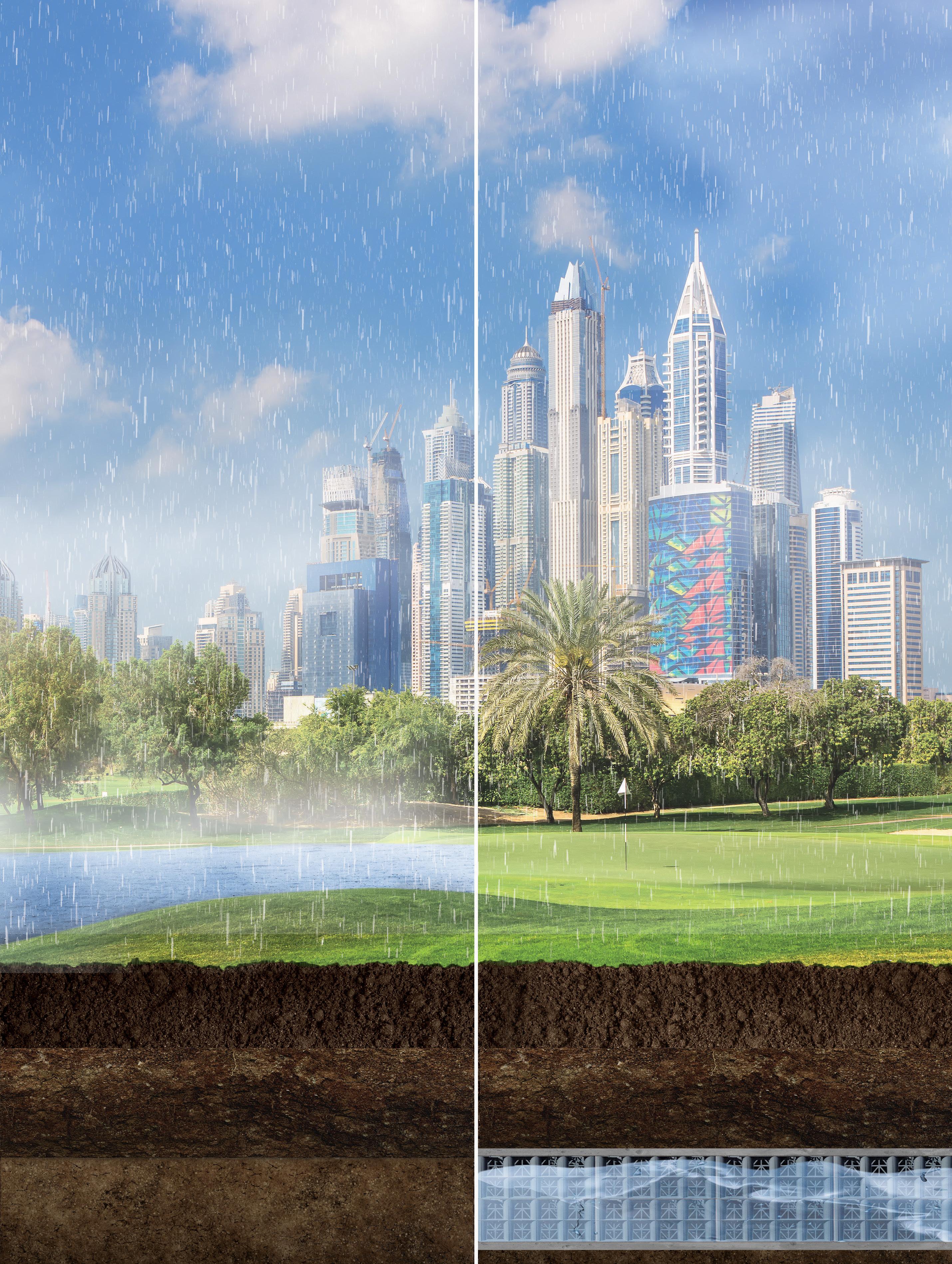
DecarbonomicsTM
Making removing carbon








































 Roni Araiji, Managing Director Middle East, Hitachi Zosen Inova
Roni Araiji, Managing Director Middle East, Hitachi Zosen Inova














































